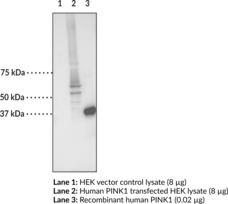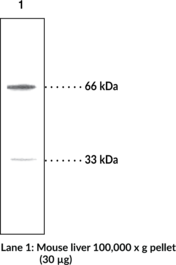Cayman
Showing 35251–35400 of 45550 results
-
Hypoxic cells are low oxygen cells that when present in tumors are radioresistant and chemoresistant. Pimonidazole is a small molecule radiosensitizer that has proven to be an effective and nontoxic hypoxia marker for human squamous cell carcinomas of the cervix, head, and neck.{15586} This immunochemical hypoxia marker has been widely used in experimental and clinical studies due to its chemical stability, water solubility, and wide tissue distribution. It is generally administered in aqueous solution by injection.
Brand:CaymanSKU:89130 - 10 mgAvailable on backorder
-
Hypoxic cells are low oxygen cells that when present in tumors are radioresistant and chemoresistant. Pimonidazole is a small molecule radiosensitizer that has proven to be an effective and nontoxic hypoxia marker for human squamous cell carcinomas of the cervix, head, and neck.{15586} This immunochemical hypoxia marker has been widely used in experimental and clinical studies due to its chemical stability, water solubility, and wide tissue distribution. It is generally administered in aqueous solution by injection.
Brand:CaymanSKU:89130 - 100 mgAvailable on backorder
-
Hypoxic cells are low oxygen cells that when present in tumors are radioresistant and chemoresistant. Pimonidazole is a small molecule radiosensitizer that has proven to be an effective and nontoxic hypoxia marker for human squamous cell carcinomas of the cervix, head, and neck.{15586} This immunochemical hypoxia marker has been widely used in experimental and clinical studies due to its chemical stability, water solubility, and wide tissue distribution. It is generally administered in aqueous solution by injection.
Brand:CaymanSKU:89130 - 5 mgAvailable on backorder
-
Hypoxic cells are low oxygen cells that when present in tumors are radioresistant and chemoresistant. Pimonidazole is a small molecule radiosensitizer that has proven to be an effective and nontoxic hypoxia marker for human squamous cell carcinomas of the cervix, head, and neck.{15586} This immunochemical hypoxia marker has been widely used in experimental and clinical studies due to its chemical stability, water solubility, and wide tissue distribution. It is generally administered in aqueous solution by injection.
Brand:CaymanSKU:89130 - 50 mgAvailable on backorder
-
Pimozide is a dopamine receptor antagonist (Kis = 2.4, 0.3, and 1.8 nM for D2, D3, and D4 receptors, respectively).{25512} It also binds to eight additional receptors (Kds = 25-3,100 nM for the human receptors) and inhibits the voltage-gated sodium channel Nav1.2 and the voltage-gated potassium channel Kv11.1 (IC50s = 42 and 340 nM, respectively).{25511,26443,26441} Pimozide (0.5, 1, and 2 mg/kg) decreases the number of licks and reduces fluid intake of a sweetened solution in rats.{45613} It decreases the number of threats and attacks and increases immobility time in the neutral arena aggression test, indicating increased passiveness, in male mice when administered at a dose of 0.75 mg/kg for 10 days.{45614} Formulations containing pimozide have been used in the treatment of Tourette syndrome.
Brand:CaymanSKU:- -
Pimozide is a dopamine receptor antagonist (Kis = 2.4, 0.3, and 1.8 nM for D2, D3, and D4 receptors, respectively).{25512} It also binds to eight additional receptors (Kds = 25-3,100 nM for the human receptors) and inhibits the voltage-gated sodium channel Nav1.2 and the voltage-gated potassium channel Kv11.1 (IC50s = 42 and 340 nM, respectively).{25511,26443,26441} Pimozide (0.5, 1, and 2 mg/kg) decreases the number of licks and reduces fluid intake of a sweetened solution in rats.{45613} It decreases the number of threats and attacks and increases immobility time in the neutral arena aggression test, indicating increased passiveness, in male mice when administered at a dose of 0.75 mg/kg for 10 days.{45614} Formulations containing pimozide have been used in the treatment of Tourette syndrome.
Brand:CaymanSKU:- -
Pimozide is a dopamine receptor antagonist (Kis = 2.4, 0.3, and 1.8 nM for D2, D3, and D4 receptors, respectively).{25512} It also binds to eight additional receptors (Kds = 25-3,100 nM for the human receptors) and inhibits the voltage-gated sodium channel Nav1.2 and the voltage-gated potassium channel Kv11.1 (IC50s = 42 and 340 nM, respectively).{25511,26443,26441} Pimozide (0.5, 1, and 2 mg/kg) decreases the number of licks and reduces fluid intake of a sweetened solution in rats.{45613} It decreases the number of threats and attacks and increases immobility time in the neutral arena aggression test, indicating increased passiveness, in male mice when administered at a dose of 0.75 mg/kg for 10 days.{45614} Formulations containing pimozide have been used in the treatment of Tourette syndrome.
Brand:CaymanSKU:- -
Pimozide-d4 is an internal standard for the quantification of pimozide (Item No. 16222) by GC- or LC-MS. Pimozide is a dopamine receptor antagonist (Kis = 2.4, 0.3, and 1.8 nM for D2, D3, and D4 receptors, respectively).{25512} It also binds to eight additional receptors (Kds = 25-3,100 nM for the human receptors) and inhibits the voltage-gated sodium channel Nav1.2 and the voltage-gated potassium channel Kv11.1 (IC50s = 42 and 340 nM, respectively).{25511,26443,26441} Pimozide (0.5, 1, and 2 mg/kg) decreases the number of licks and reduces fluid intake of a sweetened solution in rats.{45613} It decreases the number of threats and attacks and increases immobility time in the neutral arena aggression test, indicating increased passiveness, in male mice when administered at a dose of 0.75 mg/kg for 10 days.{45614} Formulations containing pimozide have been used in the treatment of Tourette syndrome.
Brand:CaymanSKU:28617 - 1 mgAvailable on backorder
-
Pimprinine is an alkaloid originally isolated from Streptomyces that has diverse biological activities, including anticonvulsant, antiplatelet, and antimicrobial properties.{36886,36887,36889,36888} It inhibits deamination of serotonin (5-HT; Item No. 14332) by monoamine oxidase (MAO; IC50 = 48 μM).{36886} Pimprinine (80 mg/kg) increases the minimum and maximum electroshock seizure thresholds in mice.{36887} In a mouse model of tremorine-induced tremors, it increases the latency to tremor onset, as well as reduces the intensity and duration of tremors and the analgesic activity of tremorine when administered at a dose of 80 mg/kg. Pimprinine inhibits aggregation of rabbit platelets induced by arachidonic acid (Item Nos. 90010 | 10006607) or collagen (IC50s = 3 and 25 μg/ml, respectively) and arachidonic acid-induced thromboxane A2 (TXA2) synthesis in rabbit platelets in vitro (IC50 = 6 μg/ml).{36889} It also inhibits the growth of M. tuberculosis, P. varioti, C. albicans, and S. lutea in vitro (MICs = 25, 1, 1.5, and 2.5 μg/ml, respectively).{36888,36887}
Brand:CaymanSKU:25507 - 1 mgAvailable on backorder
-
Pimprinine is an alkaloid originally isolated from Streptomyces that has diverse biological activities, including anticonvulsant, antiplatelet, and antimicrobial properties.{36886,36887,36889,36888} It inhibits deamination of serotonin (5-HT; Item No. 14332) by monoamine oxidase (MAO; IC50 = 48 μM).{36886} Pimprinine (80 mg/kg) increases the minimum and maximum electroshock seizure thresholds in mice.{36887} In a mouse model of tremorine-induced tremors, it increases the latency to tremor onset, as well as reduces the intensity and duration of tremors and the analgesic activity of tremorine when administered at a dose of 80 mg/kg. Pimprinine inhibits aggregation of rabbit platelets induced by arachidonic acid (Item Nos. 90010 | 10006607) or collagen (IC50s = 3 and 25 μg/ml, respectively) and arachidonic acid-induced thromboxane A2 (TXA2) synthesis in rabbit platelets in vitro (IC50 = 6 μg/ml).{36889} It also inhibits the growth of M. tuberculosis, P. varioti, C. albicans, and S. lutea in vitro (MICs = 25, 1, 1.5, and 2.5 μg/ml, respectively).{36888,36887}
Brand:CaymanSKU:25507 - 5 mgAvailable on backorder
-
Pinacidil is a cyanoguanidine compound that acts as a potassium channel opener, activating the ATP-modulated potassium channels of guinea pig bladder and heart with Ki values of 104 and 251 nM, respectively.{25813,25181,22674} It completely relaxes coronary artery rings preconstricted with serotonin (Item No. 14332; IC50 = 1.26 µM).{25180} Through this mechanism, pinacidil causes vascular relaxation, decreases peripheral vascular resistance, and reduces hypertension in animals and humans.{25812,25814}
Brand:CaymanSKU:- -
Pinacidil is a cyanoguanidine compound that acts as a potassium channel opener, activating the ATP-modulated potassium channels of guinea pig bladder and heart with Ki values of 104 and 251 nM, respectively.{25813,25181,22674} It completely relaxes coronary artery rings preconstricted with serotonin (Item No. 14332; IC50 = 1.26 µM).{25180} Through this mechanism, pinacidil causes vascular relaxation, decreases peripheral vascular resistance, and reduces hypertension in animals and humans.{25812,25814}
Brand:CaymanSKU:- -
Pinacidil is a cyanoguanidine compound that acts as a potassium channel opener, activating the ATP-modulated potassium channels of guinea pig bladder and heart with Ki values of 104 and 251 nM, respectively.{25813,25181,22674} It completely relaxes coronary artery rings preconstricted with serotonin (Item No. 14332; IC50 = 1.26 µM).{25180} Through this mechanism, pinacidil causes vascular relaxation, decreases peripheral vascular resistance, and reduces hypertension in animals and humans.{25812,25814}
Brand:CaymanSKU:- -
Pinacidil is a cyanoguanidine compound that acts as a potassium channel opener, activating the ATP-modulated potassium channels of guinea pig bladder and heart with Ki values of 104 and 251 nM, respectively.{25813,25181,22674} It completely relaxes coronary artery rings preconstricted with serotonin (Item No. 14332; IC50 = 1.26 µM).{25180} Through this mechanism, pinacidil causes vascular relaxation, decreases peripheral vascular resistance, and reduces hypertension in animals and humans.{25812,25814}
Brand:CaymanSKU:- -
Pinane thromboxane A2 (PTA2) is a stable analog of TXA2. It is a TP receptor antagonist and an inhibitor of thromboxane synthase.{516,794} PTA2 inhibits U-46619-induced cat coronary artery constriction (ID50 = 0.1 µM), U-46619-induced aggregation of human platelets (IC50 = 2 µM), and rabbit platelet thromboxane synthase (ID50 = 50 µM). PTA2 does not affect PGI synthase up to a concentration of 100 µM.{516}
Brand:CaymanSKU:-Available on backorder
-
Pinane thromboxane A2 (PTA2) is a stable analog of TXA2. It is a TP receptor antagonist and an inhibitor of thromboxane synthase.{516,794} PTA2 inhibits U-46619-induced cat coronary artery constriction (ID50 = 0.1 µM), U-46619-induced aggregation of human platelets (IC50 = 2 µM), and rabbit platelet thromboxane synthase (ID50 = 50 µM). PTA2 does not affect PGI synthase up to a concentration of 100 µM.{516}
Brand:CaymanSKU:-Available on backorder
-
Pinane thromboxane A2 (PTA2) is a stable analog of TXA2. It is a TP receptor antagonist and an inhibitor of thromboxane synthase.{516,794} PTA2 inhibits U-46619-induced cat coronary artery constriction (ID50 = 0.1 µM), U-46619-induced aggregation of human platelets (IC50 = 2 µM), and rabbit platelet thromboxane synthase (ID50 = 50 µM). PTA2 does not affect PGI synthase up to a concentration of 100 µM.{516}
Brand:CaymanSKU:-Available on backorder
-
Pinane thromboxane A2 (PTA2) is a stable analog of TXA2. It is a TP receptor antagonist and an inhibitor of thromboxane synthase.{516,794} PTA2 inhibits U-46619-induced cat coronary artery constriction (ID50 = 0.1 µM), U-46619-induced aggregation of human platelets (IC50 = 2 µM), and rabbit platelet thromboxane synthase (ID50 = 50 µM). PTA2 does not affect PGI synthase up to a concentration of 100 µM.{516}
Brand:CaymanSKU:-Available on backorder
-
Pindolol is an antagonist of β1- and β2-adrenergic receptors (β1- and β2-ARs; Kis = 2.6 and 4.8 nM, respectively) and a partial agonist of the β3-AR, stimulating adenylyl cyclase in membranes of cells expressing the human receptor.{37170,25395} It is also an antagonist of the serotonin 5-HT1A receptor (Ki = 81.1 nM for inhibition of 5-HT-stimulated GTPγS binding).{39331} Pindolol inhibits isoproterenol-induced tachycardia in anesthetized cats (ED50 = 1.8 µg/kg).{37171} It also decreases mean blood pressure in conscious spontaneously hypertensive rats when administered at a dose of 30 mg/kg per day, but concomitantly increases heart rate.{41850} Formulations containing pindolol have been used in the treatment of hypertension.
Brand:CaymanSKU:21445 -Out of stock
-
Pindolol is an antagonist of β1- and β2-adrenergic receptors (β1- and β2-ARs; Kis = 2.6 and 4.8 nM, respectively) and a partial agonist of the β3-AR, stimulating adenylyl cyclase in membranes of cells expressing the human receptor.{37170,25395} It is also an antagonist of the serotonin 5-HT1A receptor (Ki = 81.1 nM for inhibition of 5-HT-stimulated GTPγS binding).{39331} Pindolol inhibits isoproterenol-induced tachycardia in anesthetized cats (ED50 = 1.8 µg/kg).{37171} It also decreases mean blood pressure in conscious spontaneously hypertensive rats when administered at a dose of 30 mg/kg per day, but concomitantly increases heart rate.{41850} Formulations containing pindolol have been used in the treatment of hypertension.
Brand:CaymanSKU:21445 -Out of stock
-
Pindolol is an antagonist of β1- and β2-adrenergic receptors (β1- and β2-ARs; Kis = 2.6 and 4.8 nM, respectively) and a partial agonist of the β3-AR, stimulating adenylyl cyclase in membranes of cells expressing the human receptor.{37170,25395} It is also an antagonist of the serotonin 5-HT1A receptor (Ki = 81.1 nM for inhibition of 5-HT-stimulated GTPγS binding).{39331} Pindolol inhibits isoproterenol-induced tachycardia in anesthetized cats (ED50 = 1.8 µg/kg).{37171} It also decreases mean blood pressure in conscious spontaneously hypertensive rats when administered at a dose of 30 mg/kg per day, but concomitantly increases heart rate.{41850} Formulations containing pindolol have been used in the treatment of hypertension.
Brand:CaymanSKU:21445 -Out of stock
-
Pindolol is an antagonist of β1- and β2-adrenergic receptors (β1- and β2-ARs; Kis = 2.6 and 4.8 nM, respectively) and a partial agonist of the β3-AR, stimulating adenylyl cyclase in membranes of cells expressing the human receptor.{37170,25395} It is also an antagonist of the serotonin 5-HT1A receptor (Ki = 81.1 nM for inhibition of 5-HT-stimulated GTPγS binding).{39331} Pindolol inhibits isoproterenol-induced tachycardia in anesthetized cats (ED50 = 1.8 µg/kg).{37171} It also decreases mean blood pressure in conscious spontaneously hypertensive rats when administered at a dose of 30 mg/kg per day, but concomitantly increases heart rate.{41850} Formulations containing pindolol have been used in the treatment of hypertension.
Brand:CaymanSKU:21445 -Out of stock
-
PTEN-induced putative kinase 1 (PINK1) is a serine/threonine protein kinase that has a role in mitochondrial function.{54198,54199} It is comprised of an N-terminal mitochondrial targeting sequence, a transmembrane domain, a serine/threonine kinase domain, and a C-terminal region.{54199} PINK1 is ubiquitously expressed primarily in the brain, skeletal muscle, and heart.{54200} It localizes to the mitochondria where it is either rapidly degraded or, under conditions of low mitochondrial membrane potential, accumulates on the outer mitochondrial membrane, where it recruits and activates the cytosolic E3 ubiquitin ligase Parkin, which targets the mitochondria for mitophagy.{54198,54200} Pink1 knockout in rats leads to an age-dependent loss of dopaminergic neurons in the substantia nigra, as well as deficits in motor function and mitochondrial respiration.{54201} In mice, Pink1 knockout does not induce a loss of dopaminergic neurons without concomitant overexpression of α-synuclein in the substantia nigra.{54202} Loss-of-function mutations in PINK1 are causally associated with autosomal recessive early-onset Parkinson’s disease.{54200,12321} Cayman’s PINK1 Monoclonal Antibody recognizes primarily the full length protein at about 66 kDa in human tissues. This antibody can be used for ELISA and Western blot applications.
Brand:CaymanSKU:29129 - 200 µgAvailable on backorder
-
Immunogen: Recombinant human PINK1 amino acids 156-511 • Host: Mouse • Species Reactivity: (+) Human, others not tested • Cross Reactivity: (+) PINK1 • Applications: ELISA, WB
Brand:CaymanSKU:29129- 200 µgAvailable on backorder
-
Immunogen: Recombinant human PINK1 amino acids 156-511 • Host: Mouse • Species Reactivity: (+) Human, others not tested • Cross Reactivity: (+) PINK1 • Applications: ELISA, WB
Brand:CaymanSKU:29129- 200 µg -
Immunogen: Synthetic peptide from the C-terminal region of human PINK1 • Host: Rabbit • Species Reactivity: (+) Human, mouse, rat; other species not tested • Applications: IHC, WB • MW: 66 and 33 kDa for the full-length and truncated form, respectively
Brand:CaymanSKU:10006283- 1 eaAvailable on backorder
-
Immunogen: Synthetic peptide from the C-terminal region of human PINK1 • Host: Rabbit • Species Reactivity: (+) Human, mouse, rat; other species not tested • Applications: IHC, WB • MW: 66 and 33 kDa for the full-length and truncated form, respectively
Brand:CaymanSKU:10006283- 1 ea -
PTEN-induced putative kinase 1 (PINK1) is a serine/threonine protein kinase that has a role in mitochondrial function.{54198,54199} It is comprised of an N-terminal mitochondrial targeting sequence, a transmembrane domain, a serine/threonine kinase domain, and a C-terminal region.{54199} PINK1 is ubiquitously expressed primarily in the brain, skeletal muscle, and heart.{54200} It localizes to the mitochondria where it is either rapidly degraded or, under conditions of low mitochondrial membrane potential, accumulates on the outer mitochondrial membrane, where it recruits and activates the cytosolic E3 ubiquitin ligase Parkin, which targets the mitochondria for mitophagy.{54200,54198} Pink1 knockout in rats leads to an age-dependent loss of dopaminergic neurons in the substantia nigra, as well as deficits in motor function and mitochondrial respiration.{54201} In mice, Pink1 knockout does not induce a loss of dopaminergic neurons without concomitant overexpression of α-synuclein in the substantia nigra.{54202} Loss-of-function mutations in PINK1 are causally associated with autosomal recessive early-onset Parkinson’s disease.{54200,12321} Cayman’s PINK1 Polyclonal Antibody can be used for immunohistochemistry (IHC) and Western blot (WB) applications. The antibody primarily recognizes full-length PINK1 at approximately 66 kDa from human, mouse, and rat samples but also detects a truncated form of the protein at approximately 33 kDa.
Brand:CaymanSKU:10006283 - 1 eaAvailable on backorder
-
Pinocembrin is a flavonoid that has been found in Eucalyptus, and has diverse biological activities.{52452,52453,52454,52455,52456} It induces apoptosis in, and inhibits the migration of, SKOV3 ovarian cancer cells when used at a concentration of 200 µM.{52453} Pinocembrin (5 mg/kg) reduces lesion volume, as well as brain microglial activation and production of IL-1β, IL-6, and TNF-α in a mouse model of collagenase-induced intracerebral hemorrhage (ICH).{52454} It prevents increases in plasma and kidney malondialdehyde (MDA) levels, glomeruli lobulation, mesangial expansion, and tubule vacuolization and occlusion, and it decreases hepatic cholesterol, triglyceride, and LDL levels in a rat model of diabetic nephropathy.{52455} Pinocembrin (20 and 50 mg/kg) reduces pulmonary edema, as well as neutrophil, lymphocyte, and macrophage infiltration in a mouse model of LPS-induced lung injury.{52456}
Brand:CaymanSKU:29852 - 10 mgAvailable on backorder
-
Pinocembrin is a flavonoid that has been found in Eucalyptus, and has diverse biological activities.{52452,52453,52454,52455,52456} It induces apoptosis in, and inhibits the migration of, SKOV3 ovarian cancer cells when used at a concentration of 200 µM.{52453} Pinocembrin (5 mg/kg) reduces lesion volume, as well as brain microglial activation and production of IL-1β, IL-6, and TNF-α in a mouse model of collagenase-induced intracerebral hemorrhage (ICH).{52454} It prevents increases in plasma and kidney malondialdehyde (MDA) levels, glomeruli lobulation, mesangial expansion, and tubule vacuolization and occlusion, and it decreases hepatic cholesterol, triglyceride, and LDL levels in a rat model of diabetic nephropathy.{52455} Pinocembrin (20 and 50 mg/kg) reduces pulmonary edema, as well as neutrophil, lymphocyte, and macrophage infiltration in a mouse model of LPS-induced lung injury.{52456}
Brand:CaymanSKU:29852 - 100 mgAvailable on backorder
-
Pinocembrin is a flavonoid that has been found in Eucalyptus, and has diverse biological activities.{52452,52453,52454,52455,52456} It induces apoptosis in, and inhibits the migration of, SKOV3 ovarian cancer cells when used at a concentration of 200 µM.{52453} Pinocembrin (5 mg/kg) reduces lesion volume, as well as brain microglial activation and production of IL-1β, IL-6, and TNF-α in a mouse model of collagenase-induced intracerebral hemorrhage (ICH).{52454} It prevents increases in plasma and kidney malondialdehyde (MDA) levels, glomeruli lobulation, mesangial expansion, and tubule vacuolization and occlusion, and it decreases hepatic cholesterol, triglyceride, and LDL levels in a rat model of diabetic nephropathy.{52455} Pinocembrin (20 and 50 mg/kg) reduces pulmonary edema, as well as neutrophil, lymphocyte, and macrophage infiltration in a mouse model of LPS-induced lung injury.{52456}
Brand:CaymanSKU:29852 - 250 mgAvailable on backorder
-
Pinocembrin is a flavonoid that has been found in Eucalyptus, and has diverse biological activities.{52452,52453,52454,52455,52456} It induces apoptosis in, and inhibits the migration of, SKOV3 ovarian cancer cells when used at a concentration of 200 µM.{52453} Pinocembrin (5 mg/kg) reduces lesion volume, as well as brain microglial activation and production of IL-1β, IL-6, and TNF-α in a mouse model of collagenase-induced intracerebral hemorrhage (ICH).{52454} It prevents increases in plasma and kidney malondialdehyde (MDA) levels, glomeruli lobulation, mesangial expansion, and tubule vacuolization and occlusion, and it decreases hepatic cholesterol, triglyceride, and LDL levels in a rat model of diabetic nephropathy.{52455} Pinocembrin (20 and 50 mg/kg) reduces pulmonary edema, as well as neutrophil, lymphocyte, and macrophage infiltration in a mouse model of LPS-induced lung injury.{52456}
Brand:CaymanSKU:29852 - 50 mgAvailable on backorder
-
Pinolenic acid is a polyunsaturated fatty acid found in Korean pine (Pinus orientalis) and maritime pine (Pinus pinaster) seed oils. Both oils have been found to have lipid-lowering properties. A diet containing maritime pine seed oil (MPSO) lowered HDL and ApoA1 levels in transgenic mice expressing human ApoA1. MPSO was found to diminish cholesterol efflux in vitro.{14273} Korean pine seed oil supplements may help in obesity by reduction of appetite. People taking this oil had an increase in the satiety hormones CCK and GLP-1 and a reduced desire to eat.{14280} The activity of the oil is attributed to pinolenic acid. Pinolenic acid is not converted to arachidonic acid metabolically and can reduce arachidonic acid levels in the phosphatidylinositol fraction of HepG2 cells from 15.9% to 7.0%.{8724}
Brand:CaymanSKU:10008654 - 10 mgAvailable on backorder
-
Pinolenic acid is a polyunsaturated fatty acid found in Korean pine (Pinus orientalis) and maritime pine (Pinus pinaster) seed oils. Both oils have been found to have lipid-lowering properties. A diet containing maritime pine seed oil (MPSO) lowered HDL and ApoA1 levels in transgenic mice expressing human ApoA1. MPSO was found to diminish cholesterol efflux in vitro.{14273} Korean pine seed oil supplements may help in obesity by reduction of appetite. People taking this oil had an increase in the satiety hormones CCK and GLP-1 and a reduced desire to eat.{14280} The activity of the oil is attributed to pinolenic acid. Pinolenic acid is not converted to arachidonic acid metabolically and can reduce arachidonic acid levels in the phosphatidylinositol fraction of HepG2 cells from 15.9% to 7.0%.{8724}
Brand:CaymanSKU:10008654 - 100 mgAvailable on backorder
-
Pinolenic acid is a polyunsaturated fatty acid found in Korean pine (Pinus orientalis) and maritime pine (Pinus pinaster) seed oils. Both oils have been found to have lipid-lowering properties. A diet containing maritime pine seed oil (MPSO) lowered HDL and ApoA1 levels in transgenic mice expressing human ApoA1. MPSO was found to diminish cholesterol efflux in vitro.{14273} Korean pine seed oil supplements may help in obesity by reduction of appetite. People taking this oil had an increase in the satiety hormones CCK and GLP-1 and a reduced desire to eat.{14280} The activity of the oil is attributed to pinolenic acid. Pinolenic acid is not converted to arachidonic acid metabolically and can reduce arachidonic acid levels in the phosphatidylinositol fraction of HepG2 cells from 15.9% to 7.0%.{8724}
Brand:CaymanSKU:10008654 - 25 mgAvailable on backorder
-
Pinolenic acid is a polyunsaturated fatty acid found in Korean pine (Pinus orientalis) and maritime pine (Pinus pinaster) seed oils. Both oils have been found to have lipid-lowering properties. A diet containing maritime pine seed oil (MPSO) lowered HDL and ApoA1 levels in transgenic mice expressing human ApoA1. MPSO was found to diminish cholesterol efflux in vitro.{14273} Korean pine seed oil supplements may help in obesity by reduction of appetite. People taking this oil had an increase in the satiety hormones CCK and GLP-1 and a reduced desire to eat.{14280} The activity of the oil is attributed to pinolenic acid. Pinolenic acid is not converted to arachidonic acid metabolically and can reduce arachidonic acid levels in the phosphatidylinositol fraction of HepG2 cells from 15.9% to 7.0%.{8724}
Brand:CaymanSKU:10008654 - 50 mgAvailable on backorder
-
Pinolenic acid is a polyunsaturated fatty acid found in Korean pine (Pinus orientalis) and maritime pine (Pinus pinaster) seed oils. Both oils have been found to have lipid-lowering properties. A diet containing maritime pine seed oil (MPSO) lowered high-density lipoprotein and ApoA1 levels in transgenic mice expressing human ApoA1. MPSO was found to diminish cholesterol efflux in vitro.{14273} Korean pine seed oil supplements may help in obesity by reduction of appetite. People taking this oil had an increase in the satiety hormones CCK and GLP-1 and a reduced desire to eat.{14280} The activity of the oil is attributed to pinolenic acid. Pinolenic acid is not converted to arachidonic acid metabolically and can reduce arachidonic acid levels in the phosphatidylinositol fraction of HepG2 cells from 15.9% to 7.0%.{8724} Pinolenic acid ethyl ester is a neutral, more lipophilic form of the free acid.
Brand:CaymanSKU:10008658 - 10 mgAvailable on backorder
-
Pinolenic acid is a polyunsaturated fatty acid found in Korean pine (Pinus orientalis) and maritime pine (Pinus pinaster) seed oils. Both oils have been found to have lipid-lowering properties. A diet containing maritime pine seed oil (MPSO) lowered high-density lipoprotein and ApoA1 levels in transgenic mice expressing human ApoA1. MPSO was found to diminish cholesterol efflux in vitro.{14273} Korean pine seed oil supplements may help in obesity by reduction of appetite. People taking this oil had an increase in the satiety hormones CCK and GLP-1 and a reduced desire to eat.{14280} The activity of the oil is attributed to pinolenic acid. Pinolenic acid is not converted to arachidonic acid metabolically and can reduce arachidonic acid levels in the phosphatidylinositol fraction of HepG2 cells from 15.9% to 7.0%.{8724} Pinolenic acid ethyl ester is a neutral, more lipophilic form of the free acid.
Brand:CaymanSKU:10008658 - 5 mgAvailable on backorder
-
Pinolenic acid is a polyunsaturated fatty acid found in Korean pine (Pinus orientalis) and maritime pine (Pinus pinaster) seed oils. Both oils have been found to have lipid-lowering properties. A diet containing maritime pine seed oil (MPSO) lowered high-density lipoprotein and ApoA1 levels in transgenic mice expressing human ApoA1. MPSO was found to diminish cholesterol efflux in vitro.{14273} Korean pine seed oil supplements may help in obesity by reduction of appetite. People taking this oil had an increase in the satiety hormones CCK and GLP-1 and a reduced desire to eat.{14280} The activity of the oil is attributed to pinolenic acid. Pinolenic acid is not converted to arachidonic acid metabolically and can reduce arachidonic acid levels in the phosphatidylinositol fraction of HepG2 cells from 15.9% to 7.0%.{8724} Pinolenic acid ethyl ester is a neutral, more lipophilic form of the free acid.
Brand:CaymanSKU:10008658 - 50 mgAvailable on backorder
-
Pinolenic acid is a polyunsaturated fatty acid found in Korean pine (Pinus orientalis) and maritime pine (Pinus pinaster) seed oils. Both oils have been found to have lipid-lowering properties. A diet containing maritime pine seed oil (MPSO) lowered HDL and ApoA-I levels in transgenic mice expressing human ApoA-I. MPSO was found to diminish cholesterol efflux in vitro.{14273} Korean pine seed oil supplements may help in obesity by reduction of appetite. People taking this oil had an increase in the satiety hormones CCK and GLP-1 and a reduced desire to eat.{14280} The activity of the oil is attributed to pinolenic acid. Due to the non-methylene-interrupted double bond at the Δ5 position, pinolenic acid is not converted to arachidonic acid metabolically. Pinoleic acid can reduce arachidonic acid levels in the phosphatidylinositol fraction of Hep-G2 cells from 15.9% to 7.0%.{8724} Pinolenic acid methyl ester is a neutral, more lipophilic form of the free acid.
Brand:CaymanSKU:10008656 - 1 mgAvailable on backorder
-
Pinolenic acid is a polyunsaturated fatty acid found in Korean pine (Pinus orientalis) and maritime pine (Pinus pinaster) seed oils. Both oils have been found to have lipid-lowering properties. A diet containing maritime pine seed oil (MPSO) lowered HDL and ApoA-I levels in transgenic mice expressing human ApoA-I. MPSO was found to diminish cholesterol efflux in vitro.{14273} Korean pine seed oil supplements may help in obesity by reduction of appetite. People taking this oil had an increase in the satiety hormones CCK and GLP-1 and a reduced desire to eat.{14280} The activity of the oil is attributed to pinolenic acid. Due to the non-methylene-interrupted double bond at the Δ5 position, pinolenic acid is not converted to arachidonic acid metabolically. Pinoleic acid can reduce arachidonic acid levels in the phosphatidylinositol fraction of Hep-G2 cells from 15.9% to 7.0%.{8724} Pinolenic acid methyl ester is a neutral, more lipophilic form of the free acid.
Brand:CaymanSKU:10008656 - 10 mgAvailable on backorder
-
Pinolenic acid is a polyunsaturated fatty acid found in Korean pine (Pinus orientalis) and maritime pine (Pinus pinaster) seed oils. Both oils have been found to have lipid-lowering properties. A diet containing maritime pine seed oil (MPSO) lowered HDL and ApoA-I levels in transgenic mice expressing human ApoA-I. MPSO was found to diminish cholesterol efflux in vitro.{14273} Korean pine seed oil supplements may help in obesity by reduction of appetite. People taking this oil had an increase in the satiety hormones CCK and GLP-1 and a reduced desire to eat.{14280} The activity of the oil is attributed to pinolenic acid. Due to the non-methylene-interrupted double bond at the Δ5 position, pinolenic acid is not converted to arachidonic acid metabolically. Pinoleic acid can reduce arachidonic acid levels in the phosphatidylinositol fraction of Hep-G2 cells from 15.9% to 7.0%.{8724} Pinolenic acid methyl ester is a neutral, more lipophilic form of the free acid.
Brand:CaymanSKU:10008656 - 5 mgAvailable on backorder
-
Pinolenic acid is a polyunsaturated fatty acid found in Korean pine (Pinus orientalis) and maritime pine (Pinus pinaster) seed oils. Both oils have been found to have lipid-lowering properties. A diet containing maritime pine seed oil (MPSO) lowered HDL and ApoA-I levels in transgenic mice expressing human ApoA-I. MPSO was found to diminish cholesterol efflux in vitro.{14273} Korean pine seed oil supplements may help in obesity by reduction of appetite. People taking this oil had an increase in the satiety hormones CCK and GLP-1 and a reduced desire to eat.{14280} The activity of the oil is attributed to pinolenic acid. Due to the non-methylene-interrupted double bond at the Δ5 position, pinolenic acid is not converted to arachidonic acid metabolically. Pinoleic acid can reduce arachidonic acid levels in the phosphatidylinositol fraction of Hep-G2 cells from 15.9% to 7.0%.{8724} Pinolenic acid methyl ester is a neutral, more lipophilic form of the free acid.
Brand:CaymanSKU:10008656 - 50 mgAvailable on backorder
-
Pinoresinol diglucoside is a lignan that has been found in E. ulmoides and has diverse biological activities.{51136,51137,51138} It inhibits peroxidation of a linoleic acid emulsion by 64.2% when used at a concentration of 20 μg/ml, scavenges hydrogen peroxide and 2,2-diphenyl-1-picrylhydrazyl (DPPH; Item No. 14805), ABTS (Item No. 27317), and superoxide anion free radicals, and has ferrous ion metal chelating activity in cell-free assays.{51136} In vivo, pinoresinol diglucoside (10, 20, and 40 mg/kg) inhibits increases in serum levels of inorganic phosphate, IL-6, and TNF-α and decreases in serum calcium levels and transverse diameter, weight, bone mineral content, and bone mineral density of the right femur in a rat model of osteoporosis induced by dexamethasone (Item No. 11015).{51138}
Brand:CaymanSKU:27708 - 10 mgAvailable on backorder
-
Pinoresinol diglucoside is a lignan that has been found in E. ulmoides and has diverse biological activities.{51136,51137,51138} It inhibits peroxidation of a linoleic acid emulsion by 64.2% when used at a concentration of 20 μg/ml, scavenges hydrogen peroxide and 2,2-diphenyl-1-picrylhydrazyl (DPPH; Item No. 14805), ABTS (Item No. 27317), and superoxide anion free radicals, and has ferrous ion metal chelating activity in cell-free assays.{51136} In vivo, pinoresinol diglucoside (10, 20, and 40 mg/kg) inhibits increases in serum levels of inorganic phosphate, IL-6, and TNF-α and decreases in serum calcium levels and transverse diameter, weight, bone mineral content, and bone mineral density of the right femur in a rat model of osteoporosis induced by dexamethasone (Item No. 11015).{51138}
Brand:CaymanSKU:27708 - 25 mgAvailable on backorder
-
Pinoresinol diglucoside is a lignan that has been found in E. ulmoides and has diverse biological activities.{51136,51137,51138} It inhibits peroxidation of a linoleic acid emulsion by 64.2% when used at a concentration of 20 μg/ml, scavenges hydrogen peroxide and 2,2-diphenyl-1-picrylhydrazyl (DPPH; Item No. 14805), ABTS (Item No. 27317), and superoxide anion free radicals, and has ferrous ion metal chelating activity in cell-free assays.{51136} In vivo, pinoresinol diglucoside (10, 20, and 40 mg/kg) inhibits increases in serum levels of inorganic phosphate, IL-6, and TNF-α and decreases in serum calcium levels and transverse diameter, weight, bone mineral content, and bone mineral density of the right femur in a rat model of osteoporosis induced by dexamethasone (Item No. 11015).{51138}
Brand:CaymanSKU:27708 - 5 mgAvailable on backorder
-
Pinoresinol diglucoside is a lignan that has been found in E. ulmoides and has diverse biological activities.{51136,51137,51138} It inhibits peroxidation of a linoleic acid emulsion by 64.2% when used at a concentration of 20 μg/ml, scavenges hydrogen peroxide and 2,2-diphenyl-1-picrylhydrazyl (DPPH; Item No. 14805), ABTS (Item No. 27317), and superoxide anion free radicals, and has ferrous ion metal chelating activity in cell-free assays.{51136} In vivo, pinoresinol diglucoside (10, 20, and 40 mg/kg) inhibits increases in serum levels of inorganic phosphate, IL-6, and TNF-α and decreases in serum calcium levels and transverse diameter, weight, bone mineral content, and bone mineral density of the right femur in a rat model of osteoporosis induced by dexamethasone (Item No. 11015).{51138}
Brand:CaymanSKU:27708 - 50 mgAvailable on backorder
-
Pinostilbene is a stable, monomethoxylated resveratrol derivative with enhanced bioavailability compared to resveratrol.{22054} At 0.1-10 μM pinostilbene reduces neurotoxicity in SH-SY5Y cells induced by the parkinsonian mimetic 6-hydroxydopamine and scavenges 2,2-diphenyl-1-picrylhydrazyl radicals with an IC50 value of 47.1 μM.{22055}
Brand:CaymanSKU:- -
Pinostilbene is a stable, monomethoxylated resveratrol derivative with enhanced bioavailability compared to resveratrol.{22054} At 0.1-10 μM pinostilbene reduces neurotoxicity in SH-SY5Y cells induced by the parkinsonian mimetic 6-hydroxydopamine and scavenges 2,2-diphenyl-1-picrylhydrazyl radicals with an IC50 value of 47.1 μM.{22055}
Brand:CaymanSKU:- -
Pinostilbene is a stable, monomethoxylated resveratrol derivative with enhanced bioavailability compared to resveratrol.{22054} At 0.1-10 μM pinostilbene reduces neurotoxicity in SH-SY5Y cells induced by the parkinsonian mimetic 6-hydroxydopamine and scavenges 2,2-diphenyl-1-picrylhydrazyl radicals with an IC50 value of 47.1 μM.{22055}
Brand:CaymanSKU:- -
Pinostilbene is a stable, monomethoxylated resveratrol derivative with enhanced bioavailability compared to resveratrol.{22054} At 0.1-10 μM pinostilbene reduces neurotoxicity in SH-SY5Y cells induced by the parkinsonian mimetic 6-hydroxydopamine and scavenges 2,2-diphenyl-1-picrylhydrazyl radicals with an IC50 value of 47.1 μM.{22055}
Brand:CaymanSKU:- -
Pinostrobin is a flavonoid with diverse biological activities, including antioxidant, anti-inflammatory, and anticancer properties.{37107} It induces quinone reductase (QR) in murine hepatoma cells with a QR doubling concentration of 500 nM.{37108} Pinostrobin inhibits TNF-α and IL-1β production in RAW 264.7 macrophages (IC50s = 17.28 and 23.5 μM, respectively) and in LPS-stimulated rats (48.6 and 55% reduction, respectively).{37109} Pinostrobin also shows selective cytotoxicity for CCRF-CEM leukemia cells (IC50 = 10.2 μM) in a panel of eight cancer cell lines (IC50s = >30 μM).{37110}
Brand:CaymanSKU:22436 -Out of stock
-
Pinostrobin is a flavonoid with diverse biological activities, including antioxidant, anti-inflammatory, and anticancer properties.{37107} It induces quinone reductase (QR) in murine hepatoma cells with a QR doubling concentration of 500 nM.{37108} Pinostrobin inhibits TNF-α and IL-1β production in RAW 264.7 macrophages (IC50s = 17.28 and 23.5 μM, respectively) and in LPS-stimulated rats (48.6 and 55% reduction, respectively).{37109} Pinostrobin also shows selective cytotoxicity for CCRF-CEM leukemia cells (IC50 = 10.2 μM) in a panel of eight cancer cell lines (IC50s = >30 μM).{37110}
Brand:CaymanSKU:22436 -Out of stock
-
Pinostrobin is a flavonoid with diverse biological activities, including antioxidant, anti-inflammatory, and anticancer properties.{37107} It induces quinone reductase (QR) in murine hepatoma cells with a QR doubling concentration of 500 nM.{37108} Pinostrobin inhibits TNF-α and IL-1β production in RAW 264.7 macrophages (IC50s = 17.28 and 23.5 μM, respectively) and in LPS-stimulated rats (48.6 and 55% reduction, respectively).{37109} Pinostrobin also shows selective cytotoxicity for CCRF-CEM leukemia cells (IC50 = 10.2 μM) in a panel of eight cancer cell lines (IC50s = >30 μM).{37110}
Brand:CaymanSKU:22436 -Out of stock
-
Pinosylvin is a stilbene originally isolated from pine heartwood that has diverse biological activities.{51006,51007,51008,51009,51010,51011} It activates sirtuin 1 (SIRT1) and induces glucose uptake in isolated rat L6 skeletal muscle myotubes.{51007} Pinosylvin reduces radial growth in a panel of 28 plant pathogenic fungi when used at a concentration of 100 μg/ml.{51008} It reduces expression of matrix metalloproteinase-2 (MMP-2), MMP-9, and membrane type 1-MMP in and inhibits migration of HT-1080 cells.{51009} Pinosylvin (10 mg/kg, i.p.) reduces the number of tumor nodules and lung tumor weight in a CT26 mouse xenograft model of metastatic colon cancer. It decreases hind paw volume and myeloperoxidase (MPO) activity in a rat model of adjuvant-induced arthritis.{51010} Pinosylvin also exhibits plant antifeedant activity against L. americanus (snowshoe hares).{51011}
Brand:CaymanSKU:27612 - 1 mgAvailable on backorder
-
Pinosylvin is a stilbene originally isolated from pine heartwood that has diverse biological activities.{51006,51007,51008,51009,51010,51011} It activates sirtuin 1 (SIRT1) and induces glucose uptake in isolated rat L6 skeletal muscle myotubes.{51007} Pinosylvin reduces radial growth in a panel of 28 plant pathogenic fungi when used at a concentration of 100 μg/ml.{51008} It reduces expression of matrix metalloproteinase-2 (MMP-2), MMP-9, and membrane type 1-MMP in and inhibits migration of HT-1080 cells.{51009} Pinosylvin (10 mg/kg, i.p.) reduces the number of tumor nodules and lung tumor weight in a CT26 mouse xenograft model of metastatic colon cancer. It decreases hind paw volume and myeloperoxidase (MPO) activity in a rat model of adjuvant-induced arthritis.{51010} Pinosylvin also exhibits plant antifeedant activity against L. americanus (snowshoe hares).{51011}
Brand:CaymanSKU:27612 - 10 mgAvailable on backorder
-
Pinosylvin is a stilbene originally isolated from pine heartwood that has diverse biological activities.{51006,51007,51008,51009,51010,51011} It activates sirtuin 1 (SIRT1) and induces glucose uptake in isolated rat L6 skeletal muscle myotubes.{51007} Pinosylvin reduces radial growth in a panel of 28 plant pathogenic fungi when used at a concentration of 100 μg/ml.{51008} It reduces expression of matrix metalloproteinase-2 (MMP-2), MMP-9, and membrane type 1-MMP in and inhibits migration of HT-1080 cells.{51009} Pinosylvin (10 mg/kg, i.p.) reduces the number of tumor nodules and lung tumor weight in a CT26 mouse xenograft model of metastatic colon cancer. It decreases hind paw volume and myeloperoxidase (MPO) activity in a rat model of adjuvant-induced arthritis.{51010} Pinosylvin also exhibits plant antifeedant activity against L. americanus (snowshoe hares).{51011}
Brand:CaymanSKU:27612 - 25 mgAvailable on backorder
-
Pinosylvin is a stilbene originally isolated from pine heartwood that has diverse biological activities.{51006,51007,51008,51009,51010,51011} It activates sirtuin 1 (SIRT1) and induces glucose uptake in isolated rat L6 skeletal muscle myotubes.{51007} Pinosylvin reduces radial growth in a panel of 28 plant pathogenic fungi when used at a concentration of 100 μg/ml.{51008} It reduces expression of matrix metalloproteinase-2 (MMP-2), MMP-9, and membrane type 1-MMP in and inhibits migration of HT-1080 cells.{51009} Pinosylvin (10 mg/kg, i.p.) reduces the number of tumor nodules and lung tumor weight in a CT26 mouse xenograft model of metastatic colon cancer. It decreases hind paw volume and myeloperoxidase (MPO) activity in a rat model of adjuvant-induced arthritis.{51010} Pinosylvin also exhibits plant antifeedant activity against L. americanus (snowshoe hares).{51011}
Brand:CaymanSKU:27612 - 5 mgAvailable on backorder
-
Pioglitazone is an agonist of the peroxisome proliferator-activated receptor γ (PPARγ; EC50 = ~500-600 nM for both human and murine PPARγ).{10857,10670} It is selective for PPARγ over PPARα, exhibiting low level activation of PPARα at 1 µM and 5.4-fold activation at a concentration of 10 µM.{10857} Pioglitazone inhibits pyruvate oxidation and glucose production in hepatocytes when used at a concentration of 10 μM.{37440} In vivo, pioglitazone (0.3-3 mg/kg per day) reduces hyperglycemia, hyperlipidemia, and hyperinsulinemia in a dose-dependent manner in male Wistar fatty rats.{37441} It reduces the number of lesions in a transgenic rat adenocarcinoma of prostate (TRAP) model.{37442} Pioglitazone (2.5 mg/kg) also decreases production of neuroinflammatory cytokines and reduces immobility in the forced swim and tail suspension tests in a mouse model of chronic mild stress, indicating antidepressant-like activity that can be reversed by the PPARγ antagonist GW9662 (Item No. 70785).{37443}
Brand:CaymanSKU:71745 - 1 mgAvailable on backorder
-
Pioglitazone is an agonist of the peroxisome proliferator-activated receptor γ (PPARγ; EC50 = ~500-600 nM for both human and murine PPARγ).{10857,10670} It is selective for PPARγ over PPARα, exhibiting low level activation of PPARα at 1 µM and 5.4-fold activation at a concentration of 10 µM.{10857} Pioglitazone inhibits pyruvate oxidation and glucose production in hepatocytes when used at a concentration of 10 μM.{37440} In vivo, pioglitazone (0.3-3 mg/kg per day) reduces hyperglycemia, hyperlipidemia, and hyperinsulinemia in a dose-dependent manner in male Wistar fatty rats.{37441} It reduces the number of lesions in a transgenic rat adenocarcinoma of prostate (TRAP) model.{37442} Pioglitazone (2.5 mg/kg) also decreases production of neuroinflammatory cytokines and reduces immobility in the forced swim and tail suspension tests in a mouse model of chronic mild stress, indicating antidepressant-like activity that can be reversed by the PPARγ antagonist GW9662 (Item No. 70785).{37443}
Brand:CaymanSKU:71745 - 25 mgAvailable on backorder
-
Pioglitazone is an agonist of the peroxisome proliferator-activated receptor γ (PPARγ; EC50 = ~500-600 nM for both human and murine PPARγ).{10857,10670} It is selective for PPARγ over PPARα, exhibiting low level activation of PPARα at 1 µM and 5.4-fold activation at a concentration of 10 µM.{10857} Pioglitazone inhibits pyruvate oxidation and glucose production in hepatocytes when used at a concentration of 10 μM.{37440} In vivo, pioglitazone (0.3-3 mg/kg per day) reduces hyperglycemia, hyperlipidemia, and hyperinsulinemia in a dose-dependent manner in male Wistar fatty rats.{37441} It reduces the number of lesions in a transgenic rat adenocarcinoma of prostate (TRAP) model.{37442} Pioglitazone (2.5 mg/kg) also decreases production of neuroinflammatory cytokines and reduces immobility in the forced swim and tail suspension tests in a mouse model of chronic mild stress, indicating antidepressant-like activity that can be reversed by the PPARγ antagonist GW9662 (Item No. 70785).{37443}
Brand:CaymanSKU:71745 - 5 mgAvailable on backorder
-
Pioglitazone is an agonist of the peroxisome proliferator-activated receptor γ (PPARγ; EC50 = ~500-600 nM for both human and murine PPARγ).{10857,10670} It is selective for PPARγ over PPARα, exhibiting low level activation of PPARα at 1 µM and 5.4-fold activation at a concentration of 10 µM.{10857} Pioglitazone inhibits pyruvate oxidation and glucose production in hepatocytes when used at a concentration of 10 μM.{37440} In vivo, pioglitazone (0.3-3 mg/kg per day) reduces hyperglycemia, hyperlipidemia, and hyperinsulinemia in a dose-dependent manner in male Wistar fatty rats.{37441} It reduces the number of lesions in a transgenic rat adenocarcinoma of prostate (TRAP) model.{37442} Pioglitazone (2.5 mg/kg) also decreases production of neuroinflammatory cytokines and reduces immobility in the forced swim and tail suspension tests in a mouse model of chronic mild stress, indicating antidepressant-like activity that can be reversed by the PPARγ antagonist GW9662 (Item No. 70785).{37443}
Brand:CaymanSKU:71745 - 50 mgAvailable on backorder
-
Pioglitazone is an agonist of the peroxisome proliferator-activated receptor γ (PPARγ; EC50 = ~500-600 nM for both human and murine PPARγ).{10857,10670} It is selective for PPARγ over PPARα, exhibiting low level activation of PPARα at 1 µM and 5.4-fold activation at a concentration of 10 µM.{10857} Pioglitazone inhibits pyruvate oxidation and glucose production in hepatocytes when used at a concentration of 10 μM.{37440} In vivo, pioglitazone (0.3-3 mg/kg per day) reduces hyperglycemia, hyperlipidemia, and hyperinsulinemia in a dose-dependent manner in male Wistar fatty rats.{37441} It reduces the number of lesions in a transgenic rat adenocarcinoma of prostate (TRAP) model.{37442} Pioglitazone (2.5 mg/kg) also decreases production of neuroinflammatory cytokines and reduces immobility in the forced swim and tail suspension tests in a mouse model of chronic mild stress, indicating antidepressant-like activity that can be reversed by the PPARγ antagonist GW 9662 (Item No. 70785).{37443}
Brand:CaymanSKU:22263 -Out of stock
-
Pioglitazone is an agonist of the peroxisome proliferator-activated receptor γ (PPARγ; EC50 = ~500-600 nM for both human and murine PPARγ).{10857,10670} It is selective for PPARγ over PPARα, exhibiting low level activation of PPARα at 1 µM and 5.4-fold activation at a concentration of 10 µM.{10857} Pioglitazone inhibits pyruvate oxidation and glucose production in hepatocytes when used at a concentration of 10 μM.{37440} In vivo, pioglitazone (0.3-3 mg/kg per day) reduces hyperglycemia, hyperlipidemia, and hyperinsulinemia in a dose-dependent manner in male Wistar fatty rats.{37441} It reduces the number of lesions in a transgenic rat adenocarcinoma of prostate (TRAP) model.{37442} Pioglitazone (2.5 mg/kg) also decreases production of neuroinflammatory cytokines and reduces immobility in the forced swim and tail suspension tests in a mouse model of chronic mild stress, indicating antidepressant-like activity that can be reversed by the PPARγ antagonist GW 9662 (Item No. 70785).{37443}
Brand:CaymanSKU:22263 -Out of stock
-
Pioglitazone is an agonist of the peroxisome proliferator-activated receptor γ (PPARγ; EC50 = ~500-600 nM for both human and murine PPARγ).{10857,10670} It is selective for PPARγ over PPARα, exhibiting low level activation of PPARα at 1 µM and 5.4-fold activation at a concentration of 10 µM.{10857} Pioglitazone inhibits pyruvate oxidation and glucose production in hepatocytes when used at a concentration of 10 μM.{37440} In vivo, pioglitazone (0.3-3 mg/kg per day) reduces hyperglycemia, hyperlipidemia, and hyperinsulinemia in a dose-dependent manner in male Wistar fatty rats.{37441} It reduces the number of lesions in a transgenic rat adenocarcinoma of prostate (TRAP) model.{37442} Pioglitazone (2.5 mg/kg) also decreases production of neuroinflammatory cytokines and reduces immobility in the forced swim and tail suspension tests in a mouse model of chronic mild stress, indicating antidepressant-like activity that can be reversed by the PPARγ antagonist GW 9662 (Item No. 70785).{37443}
Brand:CaymanSKU:22263 -Out of stock
-
Pioglitazone is an agonist of the peroxisome proliferator-activated receptor γ (PPARγ; EC50 = ~500-600 nM for both human and murine PPARγ).{10857,10670} It is selective for PPARγ over PPARα, exhibiting low level activation of PPARα at 1 µM and 5.4-fold activation at a concentration of 10 µM.{10857} Pioglitazone inhibits pyruvate oxidation and glucose production in hepatocytes when used at a concentration of 10 μM.{37440} In vivo, pioglitazone (0.3-3 mg/kg per day) reduces hyperglycemia, hyperlipidemia, and hyperinsulinemia in a dose-dependent manner in male Wistar fatty rats.{37441} It reduces the number of lesions in a transgenic rat adenocarcinoma of prostate (TRAP) model.{37442} Pioglitazone (2.5 mg/kg) also decreases production of neuroinflammatory cytokines and reduces immobility in the forced swim and tail suspension tests in a mouse model of chronic mild stress, indicating antidepressant-like activity that can be reversed by the PPARγ antagonist GW9662 (Item No. 70785).{37443}
Brand:CaymanSKU:10028 - 1 mgAvailable on backorder
-
Pioglitazone is an agonist of the peroxisome proliferator-activated receptor γ (PPARγ; EC50 = ~500-600 nM for both human and murine PPARγ).{10857,10670} It is selective for PPARγ over PPARα, exhibiting low level activation of PPARα at 1 µM and 5.4-fold activation at a concentration of 10 µM.{10857} Pioglitazone inhibits pyruvate oxidation and glucose production in hepatocytes when used at a concentration of 10 μM.{37440} In vivo, pioglitazone (0.3-3 mg/kg per day) reduces hyperglycemia, hyperlipidemia, and hyperinsulinemia in a dose-dependent manner in male Wistar fatty rats.{37441} It reduces the number of lesions in a transgenic rat adenocarcinoma of prostate (TRAP) model.{37442} Pioglitazone (2.5 mg/kg) also decreases production of neuroinflammatory cytokines and reduces immobility in the forced swim and tail suspension tests in a mouse model of chronic mild stress, indicating antidepressant-like activity that can be reversed by the PPARγ antagonist GW9662 (Item No. 70785).{37443}
Brand:CaymanSKU:10028 - 10 mgAvailable on backorder
-
Pioglitazone is an agonist of the peroxisome proliferator-activated receptor γ (PPARγ; EC50 = ~500-600 nM for both human and murine PPARγ).{10857,10670} It is selective for PPARγ over PPARα, exhibiting low level activation of PPARα at 1 µM and 5.4-fold activation at a concentration of 10 µM.{10857} Pioglitazone inhibits pyruvate oxidation and glucose production in hepatocytes when used at a concentration of 10 μM.{37440} In vivo, pioglitazone (0.3-3 mg/kg per day) reduces hyperglycemia, hyperlipidemia, and hyperinsulinemia in a dose-dependent manner in male Wistar fatty rats.{37441} It reduces the number of lesions in a transgenic rat adenocarcinoma of prostate (TRAP) model.{37442} Pioglitazone (2.5 mg/kg) also decreases production of neuroinflammatory cytokines and reduces immobility in the forced swim and tail suspension tests in a mouse model of chronic mild stress, indicating antidepressant-like activity that can be reversed by the PPARγ antagonist GW9662 (Item No. 70785).{37443}
Brand:CaymanSKU:10028 - 5 mgAvailable on backorder
-
Pioglitazone is an agonist of the peroxisome proliferator-activated receptor γ (PPARγ; EC50 = ~500-600 nM for both human and murine PPARγ).{10857,10670} It is selective for PPARγ over PPARα, exhibiting low level activation of PPARα at 1 µM and 5.4-fold activation at a concentration of 10 µM.{10857} Pioglitazone inhibits pyruvate oxidation and glucose production in hepatocytes when used at a concentration of 10 μM.{37440} In vivo, pioglitazone (0.3-3 mg/kg per day) reduces hyperglycemia, hyperlipidemia, and hyperinsulinemia in a dose-dependent manner in male Wistar fatty rats.{37441} It reduces the number of lesions in a transgenic rat adenocarcinoma of prostate (TRAP) model.{37442} Pioglitazone (2.5 mg/kg) also decreases production of neuroinflammatory cytokines and reduces immobility in the forced swim and tail suspension tests in a mouse model of chronic mild stress, indicating antidepressant-like activity that can be reversed by the PPARγ antagonist GW9662 (Item No. 70785).{37443}
Brand:CaymanSKU:10028 - 50 mgAvailable on backorder
-
Pioglitazone ketone is an active metabolite of the PPARγ agonist pioglitazone (Item Nos. 71745 | 10028 | 22263).{49141,49142,9838} Formation of pioglitazone ketone occurs primarly through cytochrome P450 (CYP) isoform CYP2C8-mediated metabolism of pioglitazone.{49141,49142} Pioglitazone ketone (100 mg/kg in the diet) reduces blood glucose levels in a KKAy mouse model of type 2 diabetes.{9838}
Brand:CaymanSKU:28044 - 5 mgAvailable on backorder
-
Pioglitazone-d4 is intended for use as an internal standard for the quantification of pioglitazone (Item Nos. 71745 | 10028 | 22263) by GC- or LC-MS. Pioglitazone is an agonist of the peroxisome proliferator-activated receptor γ (PPARγ; EC50 = ~500-600 nM for both human and murine PPARγ).{10857,10670} It is selective for PPARγ over PPARα, exhibiting low level activation of PPARα at 1 µM and 5.4-fold activation at a concentration of 10 µM.{10857} Pioglitazone inhibits pyruvate oxidation and glucose production in hepatocytes when used at a concentration of 10 μM.{37440} In vivo, pioglitazone (0.3-3 mg/kg per day) reduces hyperglycemia, hyperlipidemia, and hyperinsulinemia in a dose-dependent manner in male Wistar fatty rats.{37441} It reduces the number of lesions in a transgenic rat adenocarcinoma of prostate (TRAP) model.{37442} Pioglitazone (2.5 mg/kg) also decreases production of neuroinflammatory cytokines and reduces immobility in the forced swim and tail suspension tests in a mouse model of chronic mild stress, indicating antidepressant-like activity that can be reversed by the PPARγ antagonist GW 9662 (Item No. 70785).{37443}
Brand:CaymanSKU:-Available on backorder
-
Pioglitazone-d4 is intended for use as an internal standard for the quantification of pioglitazone (Item Nos. 71745 | 10028 | 22263) by GC- or LC-MS. Pioglitazone is an agonist of the peroxisome proliferator-activated receptor γ (PPARγ; EC50 = ~500-600 nM for both human and murine PPARγ).{10857,10670} It is selective for PPARγ over PPARα, exhibiting low level activation of PPARα at 1 µM and 5.4-fold activation at a concentration of 10 µM.{10857} Pioglitazone inhibits pyruvate oxidation and glucose production in hepatocytes when used at a concentration of 10 μM.{37440} In vivo, pioglitazone (0.3-3 mg/kg per day) reduces hyperglycemia, hyperlipidemia, and hyperinsulinemia in a dose-dependent manner in male Wistar fatty rats.{37441} It reduces the number of lesions in a transgenic rat adenocarcinoma of prostate (TRAP) model.{37442} Pioglitazone (2.5 mg/kg) also decreases production of neuroinflammatory cytokines and reduces immobility in the forced swim and tail suspension tests in a mouse model of chronic mild stress, indicating antidepressant-like activity that can be reversed by the PPARγ antagonist GW 9662 (Item No. 70785).{37443}
Brand:CaymanSKU:-Available on backorder
-
Pipacycline is a tetracycline antibiotic derivative.{47371} It inhibits the formation of penicillinase, the enzyme that inactivates penicillin in bacteria. It decreases oxygen uptake and inhibits growth of penicillin-resistant penicillinase-producing S. aureus.
Brand:CaymanSKU:27990 - 25 mgAvailable on backorder
-
Pipacycline is a tetracycline antibiotic derivative.{47371} It inhibits the formation of penicillinase, the enzyme that inactivates penicillin in bacteria. It decreases oxygen uptake and inhibits growth of penicillin-resistant penicillinase-producing S. aureus.
Brand:CaymanSKU:27990 - 5 mgAvailable on backorder
-
Pipequaline is a partial agonist of central benzodiazepine receptors (Ki = 78 nM in a radioligand binding assay).{35203} In mice, pipequaline enhances the effects of diazepam (Item No. ISO60177), further reducing foot shock-induced fighting behavior and the number of maximal electroshock-induced seizures and potentiating the muscle relaxant and hypnotic effects.{39426} Pipequaline also increases drinking in the Vogel punished drinking task indicating anxiolytic-like activity that can be reversed by the benzodiazepine receptor antagonist flumazenil (Item No. 14252).
Brand:CaymanSKU:23888 - 10 mgAvailable on backorder
-
Pipequaline is a partial agonist of central benzodiazepine receptors (Ki = 78 nM in a radioligand binding assay).{35203} In mice, pipequaline enhances the effects of diazepam (Item No. ISO60177), further reducing foot shock-induced fighting behavior and the number of maximal electroshock-induced seizures and potentiating the muscle relaxant and hypnotic effects.{39426} Pipequaline also increases drinking in the Vogel punished drinking task indicating anxiolytic-like activity that can be reversed by the benzodiazepine receptor antagonist flumazenil (Item No. 14252).
Brand:CaymanSKU:23888 - 100 mgAvailable on backorder
-
Pipequaline is a partial agonist of central benzodiazepine receptors (Ki = 78 nM in a radioligand binding assay).{35203} In mice, pipequaline enhances the effects of diazepam (Item No. ISO60177), further reducing foot shock-induced fighting behavior and the number of maximal electroshock-induced seizures and potentiating the muscle relaxant and hypnotic effects.{39426} Pipequaline also increases drinking in the Vogel punished drinking task indicating anxiolytic-like activity that can be reversed by the benzodiazepine receptor antagonist flumazenil (Item No. 14252).
Brand:CaymanSKU:23888 - 50 mgAvailable on backorder
-
Piperacillin is a broad-spectrum β-lactam antibiotic of the penicillin class.{27901,29941} It is active against Gram-negative and Gram-positive bacteria, including Enterococcus species, E. coli, and P. mirabilis (MIC50s = 0.5-2 µg/ml) as well as gentamicin-susceptible and -resistant strains of P. aeruginosa (MIC50s = 8 and 125 µg/ml, respectively).{29941} In a mouse model of systemic infection, piperacillin is active against P. aeruginosa 46220 when used alone or in combination with tazobactam (Item No. 25679; ED50s = 1.58 and 1.34 mg/animal, respectively).{37701} In the same model, it is less active against P. aeruginosa 46220 DR-2, which contains constitutively active β-lactamase, when used alone than when used in combination with tazobactam (ED50s = >20 and 4.39 mg/animal, respectively). Formulations containing piperacillin in combination with tazobactam have been used in the treatment of moderate-to-severe bacterial infections.
Brand:CaymanSKU:20766 -Available on backorder
-
Piperacillin is a broad-spectrum β-lactam antibiotic of the penicillin class.{27901,29941} It is active against Gram-negative and Gram-positive bacteria, including Enterococcus species, E. coli, and P. mirabilis (MIC50s = 0.5-2 µg/ml) as well as gentamicin-susceptible and -resistant strains of P. aeruginosa (MIC50s = 8 and 125 µg/ml, respectively).{29941} In a mouse model of systemic infection, piperacillin is active against P. aeruginosa 46220 when used alone or in combination with tazobactam (Item No. 25679; ED50s = 1.58 and 1.34 mg/animal, respectively).{37701} In the same model, it is less active against P. aeruginosa 46220 DR-2, which contains constitutively active β-lactamase, when used alone than when used in combination with tazobactam (ED50s = >20 and 4.39 mg/animal, respectively). Formulations containing piperacillin in combination with tazobactam have been used in the treatment of moderate-to-severe bacterial infections.
Brand:CaymanSKU:20766 -Available on backorder
-
Piperacillin is a broad-spectrum β-lactam antibiotic of the penicillin class.{27901,29941} It is active against Gram-negative and Gram-positive bacteria, including Enterococcus species, E. coli, and P. mirabilis (MIC50s = 0.5-2 µg/ml) as well as gentamicin-susceptible and -resistant strains of P. aeruginosa (MIC50s = 8 and 125 µg/ml, respectively).{29941} In a mouse model of systemic infection, piperacillin is active against P. aeruginosa 46220 when used alone or in combination with tazobactam (Item No. 25679; ED50s = 1.58 and 1.34 mg/animal, respectively).{37701} In the same model, it is less active against P. aeruginosa 46220 DR-2, which contains constitutively active β-lactamase, when used alone than when used in combination with tazobactam (ED50s = >20 and 4.39 mg/animal, respectively). Formulations containing piperacillin in combination with tazobactam have been used in the treatment of moderate-to-severe bacterial infections.
Brand:CaymanSKU:20766 -Available on backorder
-
Piperacillin is a broad-spectrum β-lactam antibiotic of the penicillin class.{27901,29941} It is active against Gram-negative and Gram-positive bacteria, including Enterococcus species, E. coli, and P. mirabilis (MIC50s = 0.5-2 µg/ml) as well as gentamicin-susceptible and -resistant strains of P. aeruginosa (MIC50s = 8 and 125 µg/ml, respectively).{29941} In a mouse model of systemic infection, piperacillin is active against P. aeruginosa 46220 when used alone or in combination with tazobactam (Item No. 25679; ED50s = 1.58 and 1.34 mg/animal, respectively).{37701} In the same model, it is less active against P. aeruginosa 46220 DR-2, which contains constitutively active β-lactamase, when used alone than when used in combination with tazobactam (ED50s = >20 and 4.39 mg/animal, respectively). Formulations containing piperacillin in combination with tazobactam have been used in the treatment of moderate-to-severe bacterial infections.
Brand:CaymanSKU:20766 -Available on backorder
-
Piperafizine A is a natural methylated diketopiperazine first isolated from an actinomycete, Streptoverticillium.{31094} It potentiates the cytotoxicity of vincristine (Item No. 11764), an anti-cancer alkaloid known to be exported from cells by P-glycoprotein.{31094,21121} Piperafizine A directs the intracellular accumulation of vincristine in cancer cells to a similar degree as verapamil (Item No. 14288), a P-glycoprotein inhibitor.{31095,21122} The effects of piperafizine A on vincristine accumulation in cancer cells is dose-dependent over a range of 1 to 20 µg/ml.{31095}
Brand:CaymanSKU:-Available on backorder
-
Piperafizine A is a natural methylated diketopiperazine first isolated from an actinomycete, Streptoverticillium.{31094} It potentiates the cytotoxicity of vincristine (Item No. 11764), an anti-cancer alkaloid known to be exported from cells by P-glycoprotein.{31094,21121} Piperafizine A directs the intracellular accumulation of vincristine in cancer cells to a similar degree as verapamil (Item No. 14288), a P-glycoprotein inhibitor.{31095,21122} The effects of piperafizine A on vincristine accumulation in cancer cells is dose-dependent over a range of 1 to 20 µg/ml.{31095}
Brand:CaymanSKU:-Available on backorder
-
Piperaquine is a bis-quinoline compound that inhibits the ex vivo growth of P. falciparum isolates from malaria-infected patients with IC50s ranging from 11.8-217.3 nM.{21232} Formulations containing piperaquine have been used in combination with artemisinin (Item No. 11816) for the treatment of malaria in HIV-1-positive populations.{28281,26531,26532}
Brand:CaymanSKU:20799 -Available on backorder
-
Piperaquine is a bis-quinoline compound that inhibits the ex vivo growth of P. falciparum isolates from malaria-infected patients with IC50s ranging from 11.8-217.3 nM.{21232} Formulations containing piperaquine have been used in combination with artemisinin (Item No. 11816) for the treatment of malaria in HIV-1-positive populations.{28281,26531,26532}
Brand:CaymanSKU:20799 -Available on backorder
-
Piperaquine is a bis-quinoline compound that inhibits the ex vivo growth of P. falciparum isolates from malaria-infected patients with IC50s ranging from 11.8-217.3 nM.{21232} Formulations containing piperaquine have been used in combination with artemisinin (Item No. 11816) for the treatment of malaria in HIV-1-positive populations.{28281,26531,26532}
Brand:CaymanSKU:20799 -Available on backorder
-
Piperaquine is a bis-quinoline compound that inhibits the ex vivo growth of P. falciparum isolates from malaria-infected patients with IC50s ranging from 11.8-217.3 nM.{21232} Formulations containing piperaquine have been used in combination with artemisinin (Item No. 11816) for the treatment of malaria in HIV-1-positive populations.{28281,26531,26532}
Brand:CaymanSKU:20799 -Available on backorder
-
Piperazine (Item No. 24019) is an analytical reference standard categorized as a piperazine. This product is intended for research and forensic applications.
Brand:CaymanSKU:24019 - 100 mgAvailable on backorder
-
Piperazine (Item No. 24019) is an analytical reference standard categorized as a piperazine. This product is intended for research and forensic applications.
Brand:CaymanSKU:24019 - 50 mgAvailable on backorder
-
Piperidylthiambutene (hydrochloride) (Item No. 26335) is an analytical reference standard categorized as an opioid.{47136} It has analgesic activity in animal models.{47135} This product is intended for research and forensic applications.
Brand:CaymanSKU:26335 - 1 mgAvailable on backorder
-
Piperidylthiambutene (hydrochloride) (Item No. 26335) is an analytical reference standard categorized as an opioid.{47136} It has analgesic activity in animal models.{47135} This product is intended for research and forensic applications.
Brand:CaymanSKU:26335 - 5 mgAvailable on backorder
-
Piperine is a natural alkaloid that can be isolated from black pepper. It activates transient receptor potential vanilloid type 1 receptor (TRPV1; EC50 = 38 µM) and modulates GABAA receptors (EC50s = 43-60 µM).{27597,27596} At similar levels, piperine inhibits both monoamine oxidases (MAOs), with IC50 values of 21 and 7 µM for MAO-A and MAO-B, respectively.{27595} Like other natural compounds containing methylenedioxyphenyl substituents, piperine affects cytochrome P450 (CYP) isoforms, inhibiting CYP3A species (Ki ~ 5 µM) and increasing expression of CYP1A and CYP2B in liver.{25115} It also has a biphasic effect on P-glycoprotein activity.{25373}
Brand:CaymanSKU:11750 - 10 gAvailable on backorder
-
Piperine is a natural alkaloid that can be isolated from black pepper. It activates transient receptor potential vanilloid type 1 receptor (TRPV1; EC50 = 38 µM) and modulates GABAA receptors (EC50s = 43-60 µM).{27597,27596} At similar levels, piperine inhibits both monoamine oxidases (MAOs), with IC50 values of 21 and 7 µM for MAO-A and MAO-B, respectively.{27595} Like other natural compounds containing methylenedioxyphenyl substituents, piperine affects cytochrome P450 (CYP) isoforms, inhibiting CYP3A species (Ki ~ 5 µM) and increasing expression of CYP1A and CYP2B in liver.{25115} It also has a biphasic effect on P-glycoprotein activity.{25373}
Brand:CaymanSKU:11750 - 100 gAvailable on backorder
-
Piperine is a natural alkaloid that can be isolated from black pepper. It activates transient receptor potential vanilloid type 1 receptor (TRPV1; EC50 = 38 µM) and modulates GABAA receptors (EC50s = 43-60 µM).{27597,27596} At similar levels, piperine inhibits both monoamine oxidases (MAOs), with IC50 values of 21 and 7 µM for MAO-A and MAO-B, respectively.{27595} Like other natural compounds containing methylenedioxyphenyl substituents, piperine affects cytochrome P450 (CYP) isoforms, inhibiting CYP3A species (Ki ~ 5 µM) and increasing expression of CYP1A and CYP2B in liver.{25115} It also has a biphasic effect on P-glycoprotein activity.{25373}
Brand:CaymanSKU:11750 - 25 gAvailable on backorder
-
Piperine is a natural alkaloid that can be isolated from black pepper. It activates transient receptor potential vanilloid type 1 receptor (TRPV1; EC50 = 38 µM) and modulates GABAA receptors (EC50s = 43-60 µM).{27597,27596} At similar levels, piperine inhibits both monoamine oxidases (MAOs), with IC50 values of 21 and 7 µM for MAO-A and MAO-B, respectively.{27595} Like other natural compounds containing methylenedioxyphenyl substituents, piperine affects cytochrome P450 (CYP) isoforms, inhibiting CYP3A species (Ki ~ 5 µM) and increasing expression of CYP1A and CYP2B in liver.{25115} It also has a biphasic effect on P-glycoprotein activity.{25373}
Brand:CaymanSKU:11750 - 5 gAvailable on backorder
-
Piperitenone is a monoterpene that has been found in various plants, including Cannabis, and has antioxidant activity.{36928,36929} It scavenges 2,2-diphenyl-1-picrylhydrazyl (DPPH; Item No. 14805) radicals in a cell free assay (IC50 = 22.7 μg/ml).{36929} Piperitenone also inhibits peroxidation of linoleic acid (Item No. 90150).
Brand:CaymanSKU:25752 - 1 mgAvailable on backorder
-
Piperitenone is a monoterpene that has been found in various plants, including Cannabis, and has antioxidant activity.{36928,36929} It scavenges 2,2-diphenyl-1-picrylhydrazyl (DPPH; Item No. 14805) radicals in a cell free assay (IC50 = 22.7 μg/ml).{36929} Piperitenone also inhibits peroxidation of linoleic acid (Item No. 90150).
Brand:CaymanSKU:25752 - 10 mgAvailable on backorder
-
Piperitenone is a monoterpene that has been found in various plants, including Cannabis, and has antioxidant activity.{36928,36929} It scavenges 2,2-diphenyl-1-picrylhydrazyl (DPPH; Item No. 14805) radicals in a cell free assay (IC50 = 22.7 μg/ml).{36929} Piperitenone also inhibits peroxidation of linoleic acid (Item No. 90150).
Brand:CaymanSKU:25752 - 5 mgAvailable on backorder
-
Cancer cell survival appears partly dependent on antioxidative enzymes, whose expression is regulated by the Keap1-Nrf2 pathway, to quench potentially toxic reactive oxygen species (ROS) generated by their metastatic transformation.{20112} Piperlongumine, isolated from the Piper longum L. plant, is a small molecule that selectively increases the level of reactive oxygen species (ROS) and apoptosis in cancer cells but not in normal cells. At concentrations less than 15 μM, piperlongumine induces cell death, upregulating proapoptotic genes, and repressing pro-survival genes.{19860} In established bladder, breast, lung, and melanoma tumor xenografts in mice, piperlongumine administered daily at 2.4 mg/kg for 2 weeks inhibits tumor growth and angiogenesis.{19860} Piperlongumine increases ROS in both cancer cells and normal cells engineered to have a cancer geneotype by selectively binding to proteins known to regulate redox and ROS homeostasis.{19860} Previously, piperlongumine has been used as a crude treatment to improve poor blood circulation. It affects platelet function in rabbits by inhibiting platelet aggregation induced by the thromboxane A2 agonist U-46619 with a Ki value of 6.8 μM.{20111}
Brand:CaymanSKU:11006 - 1 gAvailable on backorder
-
Cancer cell survival appears partly dependent on antioxidative enzymes, whose expression is regulated by the Keap1-Nrf2 pathway, to quench potentially toxic reactive oxygen species (ROS) generated by their metastatic transformation.{20112} Piperlongumine, isolated from the Piper longum L. plant, is a small molecule that selectively increases the level of reactive oxygen species (ROS) and apoptosis in cancer cells but not in normal cells. At concentrations less than 15 μM, piperlongumine induces cell death, upregulating proapoptotic genes, and repressing pro-survival genes.{19860} In established bladder, breast, lung, and melanoma tumor xenografts in mice, piperlongumine administered daily at 2.4 mg/kg for 2 weeks inhibits tumor growth and angiogenesis.{19860} Piperlongumine increases ROS in both cancer cells and normal cells engineered to have a cancer geneotype by selectively binding to proteins known to regulate redox and ROS homeostasis.{19860} Previously, piperlongumine has been used as a crude treatment to improve poor blood circulation. It affects platelet function in rabbits by inhibiting platelet aggregation induced by the thromboxane A2 agonist U-46619 with a Ki value of 6.8 μM.{20111}
Brand:CaymanSKU:11006 - 100 mgAvailable on backorder
-
Cancer cell survival appears partly dependent on antioxidative enzymes, whose expression is regulated by the Keap1-Nrf2 pathway, to quench potentially toxic reactive oxygen species (ROS) generated by their metastatic transformation.{20112} Piperlongumine, isolated from the Piper longum L. plant, is a small molecule that selectively increases the level of reactive oxygen species (ROS) and apoptosis in cancer cells but not in normal cells. At concentrations less than 15 μM, piperlongumine induces cell death, upregulating proapoptotic genes, and repressing pro-survival genes.{19860} In established bladder, breast, lung, and melanoma tumor xenografts in mice, piperlongumine administered daily at 2.4 mg/kg for 2 weeks inhibits tumor growth and angiogenesis.{19860} Piperlongumine increases ROS in both cancer cells and normal cells engineered to have a cancer geneotype by selectively binding to proteins known to regulate redox and ROS homeostasis.{19860} Previously, piperlongumine has been used as a crude treatment to improve poor blood circulation. It affects platelet function in rabbits by inhibiting platelet aggregation induced by the thromboxane A2 agonist U-46619 with a Ki value of 6.8 μM.{20111}
Brand:CaymanSKU:11006 - 25 mgAvailable on backorder
-
Cancer cell survival appears partly dependent on antioxidative enzymes, whose expression is regulated by the Keap1-Nrf2 pathway, to quench potentially toxic reactive oxygen species (ROS) generated by their metastatic transformation.{20112} Piperlongumine, isolated from the Piper longum L. plant, is a small molecule that selectively increases the level of reactive oxygen species (ROS) and apoptosis in cancer cells but not in normal cells. At concentrations less than 15 μM, piperlongumine induces cell death, upregulating proapoptotic genes, and repressing pro-survival genes.{19860} In established bladder, breast, lung, and melanoma tumor xenografts in mice, piperlongumine administered daily at 2.4 mg/kg for 2 weeks inhibits tumor growth and angiogenesis.{19860} Piperlongumine increases ROS in both cancer cells and normal cells engineered to have a cancer geneotype by selectively binding to proteins known to regulate redox and ROS homeostasis.{19860} Previously, piperlongumine has been used as a crude treatment to improve poor blood circulation. It affects platelet function in rabbits by inhibiting platelet aggregation induced by the thromboxane A2 agonist U-46619 with a Ki value of 6.8 μM.{20111}
Brand:CaymanSKU:11006 - 500 mgAvailable on backorder
-
Piperonyl butoxide is a synergist used to enhance the activity of insecticides, including pyrethrin insecticides, through inhibition of cytochrome P450 enzymes (CYPs).{37755,37756} It increases the toxicity of the pyrethroid insecticide deltamethrin (Item No. 24172) to field-collected, deltamethrin-resistant strains of the bed bug C. lectularius by 40- to 176-fold when used at a concentration of 50 μg/μL.{37756} Piperonyl butoxide also increases the toxicity of the organotin insecticide Plictran to fourth instar larvae of susceptible strains of the cotton leafworm S. littoralis (LD50s = 0.78 and 40 μg/larva with and without piperonyl butoxide, respectively), as well as field strains (LD50s = 0.015 and 1.1 μg/larva with and without piperonyl butoxide, respectively).{43336} It is not toxic to the freshwater invertebrates H. azteca, C. tentans, and L. variegatus (LC50s = 530, 2,740, and 3,540 μg/L, respectively) and reduces the toxicity of the organophosphate pesticides diazinon (Item No. 23769), chlorpyrifos (Item No. 21412), and azinphos-methyl, which require activation by CYP enzymes in these organisms.{37755} Formulations containing piperonyl butoxide have been used for the control of agricultural, household, and veterinary pests.
Brand:CaymanSKU:25820 - 100 mgAvailable on backorder
-
Piperonyl butoxide is a synergist used to enhance the activity of insecticides, including pyrethrin insecticides, through inhibition of cytochrome P450 enzymes (CYPs).{37755,37756} It increases the toxicity of the pyrethroid insecticide deltamethrin (Item No. 24172) to field-collected, deltamethrin-resistant strains of the bed bug C. lectularius by 40- to 176-fold when used at a concentration of 50 μg/μL.{37756} Piperonyl butoxide also increases the toxicity of the organotin insecticide Plictran to fourth instar larvae of susceptible strains of the cotton leafworm S. littoralis (LD50s = 0.78 and 40 μg/larva with and without piperonyl butoxide, respectively), as well as field strains (LD50s = 0.015 and 1.1 μg/larva with and without piperonyl butoxide, respectively).{43336} It is not toxic to the freshwater invertebrates H. azteca, C. tentans, and L. variegatus (LC50s = 530, 2,740, and 3,540 μg/L, respectively) and reduces the toxicity of the organophosphate pesticides diazinon (Item No. 23769), chlorpyrifos (Item No. 21412), and azinphos-methyl, which require activation by CYP enzymes in these organisms.{37755} Formulations containing piperonyl butoxide have been used for the control of agricultural, household, and veterinary pests.
Brand:CaymanSKU:25820 - 50 mgAvailable on backorder
-
Piperonyl methyl ketone is a precursor or intermediate in the synthesis of methylenedioxy phenethylamines and amphetamines, including 3,4-MDMA (Item No. 13971).{25767} It can be present as an impurity in preparations of methylenedioxy phenethylamines.{25116} The physiological and toxicological properties of this compound are not known. This product is intended for forensic and research applications.
Brand:CaymanSKU:- -
Piperonyl methyl ketone is a precursor or intermediate in the synthesis of methylenedioxy phenethylamines and amphetamines, including 3,4-MDMA (Item No. 13971).{25767} It can be present as an impurity in preparations of methylenedioxy phenethylamines.{25116} The physiological and toxicological properties of this compound are not known. This product is intended for forensic and research applications.
Brand:CaymanSKU:- -
Piperonyl methyl ketone is a precursor or intermediate in the synthesis of methylenedioxy phenethylamines and amphetamines, including 3,4-MDMA (Item No. 13971).{25767} It can be present as an impurity in preparations of methylenedioxy phenethylamines.{25116} The physiological and toxicological properties of this compound are not known. This product is intended for forensic and research applications.
Brand:CaymanSKU:- -
Piperoxan is an α2-adrenergic receptor (α2-AR) antagonist (Kis = 5.4, 2, and 1.3 nM for α2A-, α2B-, and α2C-ARs, respectively) and a first generation histamine receptor antagonist.{49273,49274} It reverses decreases in systolic blood pressure induced by clonidine (Item No. 15949) in spontaneously hypertensive rats when administered at a dose of 10 mg/kg.{49275}
Brand:CaymanSKU:27629 - 10 mgAvailable on backorder
-
Piperoxan is an α2-adrenergic receptor (α2-AR) antagonist (Kis = 5.4, 2, and 1.3 nM for α2A-, α2B-, and α2C-ARs, respectively) and a first generation histamine receptor antagonist.{49273,49274} It reverses decreases in systolic blood pressure induced by clonidine (Item No. 15949) in spontaneously hypertensive rats when administered at a dose of 10 mg/kg.{49275}
Brand:CaymanSKU:27629 - 100 mgAvailable on backorder
-
Piperoxan is an α2-adrenergic receptor (α2-AR) antagonist (Kis = 5.4, 2, and 1.3 nM for α2A-, α2B-, and α2C-ARs, respectively) and a first generation histamine receptor antagonist.{49273,49274} It reverses decreases in systolic blood pressure induced by clonidine (Item No. 15949) in spontaneously hypertensive rats when administered at a dose of 10 mg/kg.{49275}
Brand:CaymanSKU:27629 - 5 mgAvailable on backorder
-
Piperoxan is an α2-adrenergic receptor (α2-AR) antagonist (Kis = 5.4, 2, and 1.3 nM for α2A-, α2B-, and α2C-ARs, respectively) and a first generation histamine receptor antagonist.{49273,49274} It reverses decreases in systolic blood pressure induced by clonidine (Item No. 15949) in spontaneously hypertensive rats when administered at a dose of 10 mg/kg.{49275}
Brand:CaymanSKU:27629 - 50 mgAvailable on backorder
-
Piracetam (Item No. 20755) is an analytical reference standard that is structurally categorized as a nootropic. It is a cyclic derivative of γ-aminobutyric acid (GABA) that improves learning, memory, brain metabolism, and capacity in animal models.{23584,32770} It has shown efficacy in stroke rehabilitation in animal models.{32768,32769} Although its mechanism of action remains unclear, piracetam has been shown to alter the physical properties of cell membranes and to protect against hypoxia, which might underlie neuroprotective and antithrombotic actions.{32770} This product is intended for research and forensic applications.
Brand:CaymanSKU:20755 -Available on backorder
-
Piracetam (Item No. 20755) is an analytical reference standard that is structurally categorized as a nootropic. It is a cyclic derivative of γ-aminobutyric acid (GABA) that improves learning, memory, brain metabolism, and capacity in animal models.{23584,32770} It has shown efficacy in stroke rehabilitation in animal models.{32768,32769} Although its mechanism of action remains unclear, piracetam has been shown to alter the physical properties of cell membranes and to protect against hypoxia, which might underlie neuroprotective and antithrombotic actions.{32770} This product is intended for research and forensic applications.
Brand:CaymanSKU:20755 -Available on backorder
-
Piracetam (Item No. 20755) is an analytical reference standard that is structurally categorized as a nootropic. It is a cyclic derivative of γ-aminobutyric acid (GABA) that improves learning, memory, brain metabolism, and capacity in animal models.{23584,32770} It has shown efficacy in stroke rehabilitation in animal models.{32768,32769} Although its mechanism of action remains unclear, piracetam has been shown to alter the physical properties of cell membranes and to protect against hypoxia, which might underlie neuroprotective and antithrombotic actions.{32770} This product is intended for research and forensic applications.
Brand:CaymanSKU:20755 -Available on backorder
-
Pirarubicin is an anthracycline that has anticancer activity.{48552} It interacts with topoisomerase II to inhibit DNA replication. Pirarubicin inhibits the growth of human HeLa and C33A cervical, as well as T-24 bladder cancer cells (IC50s = 29, 52, and 36 ng/ml, respectively).{48553} It inhibits the growth of human Huh7 and MHCC97H liver cancer cells (IC50s = 0.159 and 0.374 μM, respectively).{48554} Pirarubicin also inhibits the growth of M5076 mouse ovarian cancer cells in vitro (IC50 = 0.366 μM) and in vivo in a mouse allograft model when administered at a dose of 2 mg/kg for four days.{48555}
Brand:CaymanSKU:28384 - 10 mgAvailable on backorder
-
Pirarubicin is an anthracycline that has anticancer activity.{48552} It interacts with topoisomerase II to inhibit DNA replication. Pirarubicin inhibits the growth of human HeLa and C33A cervical, as well as T-24 bladder cancer cells (IC50s = 29, 52, and 36 ng/ml, respectively).{48553} It inhibits the growth of human Huh7 and MHCC97H liver cancer cells (IC50s = 0.159 and 0.374 μM, respectively).{48554} Pirarubicin also inhibits the growth of M5076 mouse ovarian cancer cells in vitro (IC50 = 0.366 μM) and in vivo in a mouse allograft model when administered at a dose of 2 mg/kg for four days.{48555}
Brand:CaymanSKU:28384 - 100 mgAvailable on backorder
-
Pirarubicin is an anthracycline that has anticancer activity.{48552} It interacts with topoisomerase II to inhibit DNA replication. Pirarubicin inhibits the growth of human HeLa and C33A cervical, as well as T-24 bladder cancer cells (IC50s = 29, 52, and 36 ng/ml, respectively).{48553} It inhibits the growth of human Huh7 and MHCC97H liver cancer cells (IC50s = 0.159 and 0.374 μM, respectively).{48554} Pirarubicin also inhibits the growth of M5076 mouse ovarian cancer cells in vitro (IC50 = 0.366 μM) and in vivo in a mouse allograft model when administered at a dose of 2 mg/kg for four days.{48555}
Brand:CaymanSKU:28384 - 25 mgAvailable on backorder
-
Pirarubicin is an anthracycline that has anticancer activity.{48552} It interacts with topoisomerase II to inhibit DNA replication. Pirarubicin inhibits the growth of human HeLa and C33A cervical, as well as T-24 bladder cancer cells (IC50s = 29, 52, and 36 ng/ml, respectively).{48553} It inhibits the growth of human Huh7 and MHCC97H liver cancer cells (IC50s = 0.159 and 0.374 μM, respectively).{48554} Pirarubicin also inhibits the growth of M5076 mouse ovarian cancer cells in vitro (IC50 = 0.366 μM) and in vivo in a mouse allograft model when administered at a dose of 2 mg/kg for four days.{48555}
Brand:CaymanSKU:28384 - 5 mgAvailable on backorder
-
Pirenzepine is an antagonist of M1 muscarinic acetylcholine receptors (Ki = 11.48 nM).{49496} It is selective for M1 over M2, M3, and M4 receptors (Kis = 602.56, 151.36, and 199.53 nM, respectively). Pirenzepine inhibits ascending reflex contraction of the circular smooth muscle in isolated guinea pig ileal segments induced by intraluminal balloon inflation (IC50 = 501.19 nM). It inhibits methacholine-induced increases in ileal pressure in guinea pigs (ID50 = 724.44 nM). Pirenzepine inhibits oxotremorine-induced gastric ulcer, gastric acid secretion, and salivation in rats (ED50s = 13, 37.5, and 620 μg/kg i.v., respectively).{49497} It prevents form-deprivation myopia (FDM) in a chick model of experimental myopia.{36513}
Brand:CaymanSKU:29527 - 1 gAvailable on backorder
-
Pirenzepine is an antagonist of M1 muscarinic acetylcholine receptors (Ki = 11.48 nM).{49496} It is selective for M1 over M2, M3, and M4 receptors (Kis = 602.56, 151.36, and 199.53 nM, respectively). Pirenzepine inhibits ascending reflex contraction of the circular smooth muscle in isolated guinea pig ileal segments induced by intraluminal balloon inflation (IC50 = 501.19 nM). It inhibits methacholine-induced increases in ileal pressure in guinea pigs (ID50 = 724.44 nM). Pirenzepine inhibits oxotremorine-induced gastric ulcer, gastric acid secretion, and salivation in rats (ED50s = 13, 37.5, and 620 μg/kg i.v., respectively).{49497} It prevents form-deprivation myopia (FDM) in a chick model of experimental myopia.{36513}
Brand:CaymanSKU:29527 - 5 gAvailable on backorder
-
Pirenzepine is an antagonist of M1 muscarinic acetylcholine receptors (Ki = 11.48 nM).{49496} It is selective for M1 over M2, M3, and M4 receptors (Kis = 602.56, 151.36, and 199.53 nM, respectively). Pirenzepine inhibits ascending reflex contraction of the circular smooth muscle in isolated guinea pig ileal segments induced by intraluminal balloon inflation (IC50 = 501.19 nM). It inhibits methacholine-induced increases in ileal pressure in guinea pigs (ID50 = 724.44 nM). Pirenzepine inhibits oxotremorine-induced gastric ulcer, gastric acid secretion, and salivation in rats (ED50s = 13, 37.5, and 620 μg/kg i.v., respectively).{49497} It prevents form-deprivation myopia (FDM) in a chick model of experimental myopia.{36513}
Brand:CaymanSKU:29527 - 500 mgAvailable on backorder
-
Pirfenidone is an orally bioavailable pyridone derivative with antifibrotic, anti-inflammatory, and antioxidant activities.{42405,42406,42407,21821,21616} It inhibits TGF-β1-stimulated increases in collagen type I, fibronectin, and Hsp47 expression in A549 lung cancer cells in a concentration-dependent manner.{21821} Pirfenidone (300 mg/kg per day) inhibits fibrosis and inhibits increases in collagen content, fibrocyte pool size, and the levels of chemokines CCL2 and CCL12 in lung in a mouse model of pulmonary fibrosis induced by bleomycin (Item No. 13877).{42406} In a mouse model of non-alcoholic steatohepatitis (NASH), pirfenidone inhibits fibrosis and increases in hepatocyte apoptosis, lobular inflammation, and hepatic expression of the fibrosis-related genes Col1a1, Timp1, Tgfb1, Pdgfb, and Fgf2 when administered at a dose of 280 mg/kg but has no effect on steatosis.{42405} Pirfenidone also inhibits NADPH-dependent lipid peroxidation in sheep liver microsomes and scavenges hydroxyl radicals (IC50s = ~6 and ~2.5 mM, respectively).{42407} Formulations containing pirfenidone have been used in the treatment of idiopathic pulmonary fibrosis.
Brand:CaymanSKU:- -
Pirfenidone is an orally bioavailable pyridone derivative with antifibrotic, anti-inflammatory, and antioxidant activities.{42405,42406,42407,21821,21616} It inhibits TGF-β1-stimulated increases in collagen type I, fibronectin, and Hsp47 expression in A549 lung cancer cells in a concentration-dependent manner.{21821} Pirfenidone (300 mg/kg per day) inhibits fibrosis and inhibits increases in collagen content, fibrocyte pool size, and the levels of chemokines CCL2 and CCL12 in lung in a mouse model of pulmonary fibrosis induced by bleomycin (Item No. 13877).{42406} In a mouse model of non-alcoholic steatohepatitis (NASH), pirfenidone inhibits fibrosis and increases in hepatocyte apoptosis, lobular inflammation, and hepatic expression of the fibrosis-related genes Col1a1, Timp1, Tgfb1, Pdgfb, and Fgf2 when administered at a dose of 280 mg/kg but has no effect on steatosis.{42405} Pirfenidone also inhibits NADPH-dependent lipid peroxidation in sheep liver microsomes and scavenges hydroxyl radicals (IC50s = ~6 and ~2.5 mM, respectively).{42407} Formulations containing pirfenidone have been used in the treatment of idiopathic pulmonary fibrosis.
Brand:CaymanSKU:- -
Pirfenidone is an orally bioavailable pyridone derivative with antifibrotic, anti-inflammatory, and antioxidant activities.{42405,42406,42407,21821,21616} It inhibits TGF-β1-stimulated increases in collagen type I, fibronectin, and Hsp47 expression in A549 lung cancer cells in a concentration-dependent manner.{21821} Pirfenidone (300 mg/kg per day) inhibits fibrosis and inhibits increases in collagen content, fibrocyte pool size, and the levels of chemokines CCL2 and CCL12 in lung in a mouse model of pulmonary fibrosis induced by bleomycin (Item No. 13877).{42406} In a mouse model of non-alcoholic steatohepatitis (NASH), pirfenidone inhibits fibrosis and increases in hepatocyte apoptosis, lobular inflammation, and hepatic expression of the fibrosis-related genes Col1a1, Timp1, Tgfb1, Pdgfb, and Fgf2 when administered at a dose of 280 mg/kg but has no effect on steatosis.{42405} Pirfenidone also inhibits NADPH-dependent lipid peroxidation in sheep liver microsomes and scavenges hydroxyl radicals (IC50s = ~6 and ~2.5 mM, respectively).{42407} Formulations containing pirfenidone have been used in the treatment of idiopathic pulmonary fibrosis.
Brand:CaymanSKU:- -
Pirfenidone is an orally bioavailable pyridone derivative with antifibrotic, anti-inflammatory, and antioxidant activities.{42405,42406,42407,21821,21616} It inhibits TGF-β1-stimulated increases in collagen type I, fibronectin, and Hsp47 expression in A549 lung cancer cells in a concentration-dependent manner.{21821} Pirfenidone (300 mg/kg per day) inhibits fibrosis and inhibits increases in collagen content, fibrocyte pool size, and the levels of chemokines CCL2 and CCL12 in lung in a mouse model of pulmonary fibrosis induced by bleomycin (Item No. 13877).{42406} In a mouse model of non-alcoholic steatohepatitis (NASH), pirfenidone inhibits fibrosis and increases in hepatocyte apoptosis, lobular inflammation, and hepatic expression of the fibrosis-related genes Col1a1, Timp1, Tgfb1, Pdgfb, and Fgf2 when administered at a dose of 280 mg/kg but has no effect on steatosis.{42405} Pirfenidone also inhibits NADPH-dependent lipid peroxidation in sheep liver microsomes and scavenges hydroxyl radicals (IC50s = ~6 and ~2.5 mM, respectively).{42407} Formulations containing pirfenidone have been used in the treatment of idiopathic pulmonary fibrosis.
Brand:CaymanSKU:- -
Pirfenidone-d5 is intended for use as an internal standard for the quantification of pirfenidone (Item No. 13986) by GC- or LC-MS. Pirfenidone is an orally bioavailable pyridone derivative with antifibrotic, anti-inflammatory, and antioxidant activities.{42405,42406,42407,21821,21616} It inhibits TGF-β1-stimulated increases in collagen type I, fibronectin, and Hsp47 expression in A549 lung cancer cells in a concentration-dependent manner.{21821} Pirfenidone (300 mg/kg per day) inhibits fibrosis and inhibits increases in collagen content, fibrocyte pool size, and the levels of chemokines CCL2 and CCL12 in lung in a mouse model of pulmonary fibrosis induced by bleomycin (Item No. 13877).{42406} In a mouse model of non-alcoholic steatohepatitis (NASH), pirfenidone inhibits fibrosis and increases in hepatocyte apoptosis, lobular inflammation, and hepatic expression of the fibrosis-related genes Col1a1, Timp1, Tgfb1, Pdgfb, and Fgf2 when administered at a dose of 280 mg/kg but has no effect on steatosis.{42405} Pirfenidone also inhibits NADPH-dependent lipid peroxidation in sheep liver microsomes and scavenges hydroxyl radicals (IC50s = ~6 and ~2.5 mM, respectively).{42407} Formulations containing pirfenidone have been used in the treatment of idiopathic pulmonary fibrosis.
Brand:CaymanSKU:26452 - 1 mgAvailable on backorder
-
Pirfenidone-d5 is intended for use as an internal standard for the quantification of pirfenidone (Item No. 13986) by GC- or LC-MS. Pirfenidone is an orally bioavailable pyridone derivative with antifibrotic, anti-inflammatory, and antioxidant activities.{42405,42406,42407,21821,21616} It inhibits TGF-β1-stimulated increases in collagen type I, fibronectin, and Hsp47 expression in A549 lung cancer cells in a concentration-dependent manner.{21821} Pirfenidone (300 mg/kg per day) inhibits fibrosis and inhibits increases in collagen content, fibrocyte pool size, and the levels of chemokines CCL2 and CCL12 in lung in a mouse model of pulmonary fibrosis induced by bleomycin (Item No. 13877).{42406} In a mouse model of non-alcoholic steatohepatitis (NASH), pirfenidone inhibits fibrosis and increases in hepatocyte apoptosis, lobular inflammation, and hepatic expression of the fibrosis-related genes Col1a1, Timp1, Tgfb1, Pdgfb, and Fgf2 when administered at a dose of 280 mg/kg but has no effect on steatosis.{42405} Pirfenidone also inhibits NADPH-dependent lipid peroxidation in sheep liver microsomes and scavenges hydroxyl radicals (IC50s = ~6 and ~2.5 mM, respectively).{42407} Formulations containing pirfenidone have been used in the treatment of idiopathic pulmonary fibrosis.
Brand:CaymanSKU:26452 - 500 µgAvailable on backorder
-
Microsomal prostaglandin E2 synthase-1 (mPGES-1) and 5-lipoxygenase (5-LO) are key enzymes in the synthesis of PGE2 (Item No. 14010) and leukotrienes (LTs), respectively. PGE2 and LTs are bioactive lipids that contribute to a broad range of pathologies, including inflammation and various forms of cancer.{12243,16854} Pirinixic acid aminothiazole is a dual inhibitor of mPGES-1 and 5-LO (IC50s = 0.4 and 0.2 µM, respectively).{24884} It is a weak inhibitor of COX-1 and -2 and has no effect on 12- and 15-LO isoforms.{24884} Pirinixic acid aminothiazole reduces the synthesis of PGE2 and LTC4 (Item No. 20210) during zymosan-induced peritonitis in mice, resulting in a significantly diminished inflammatory response.{24884}
Brand:CaymanSKU:- -
Microsomal prostaglandin E2 synthase-1 (mPGES-1) and 5-lipoxygenase (5-LO) are key enzymes in the synthesis of PGE2 (Item No. 14010) and leukotrienes (LTs), respectively. PGE2 and LTs are bioactive lipids that contribute to a broad range of pathologies, including inflammation and various forms of cancer.{12243,16854} Pirinixic acid aminothiazole is a dual inhibitor of mPGES-1 and 5-LO (IC50s = 0.4 and 0.2 µM, respectively).{24884} It is a weak inhibitor of COX-1 and -2 and has no effect on 12- and 15-LO isoforms.{24884} Pirinixic acid aminothiazole reduces the synthesis of PGE2 and LTC4 (Item No. 20210) during zymosan-induced peritonitis in mice, resulting in a significantly diminished inflammatory response.{24884}
Brand:CaymanSKU:- -
Microsomal prostaglandin E2 synthase-1 (mPGES-1) and 5-lipoxygenase (5-LO) are key enzymes in the synthesis of PGE2 (Item No. 14010) and leukotrienes (LTs), respectively. PGE2 and LTs are bioactive lipids that contribute to a broad range of pathologies, including inflammation and various forms of cancer.{12243,16854} Pirinixic acid aminothiazole is a dual inhibitor of mPGES-1 and 5-LO (IC50s = 0.4 and 0.2 µM, respectively).{24884} It is a weak inhibitor of COX-1 and -2 and has no effect on 12- and 15-LO isoforms.{24884} Pirinixic acid aminothiazole reduces the synthesis of PGE2 and LTC4 (Item No. 20210) during zymosan-induced peritonitis in mice, resulting in a significantly diminished inflammatory response.{24884}
Brand:CaymanSKU:- -
Microsomal prostaglandin E2 synthase-1 (mPGES-1) and 5-lipoxygenase (5-LO) are key enzymes in the synthesis of PGE2 (Item No. 14010) and leukotrienes (LTs), respectively. PGE2 and LTs are bioactive lipids that contribute to a broad range of pathologies, including inflammation and various forms of cancer.{12243,16854} Pirinixic acid aminothiazole is a dual inhibitor of mPGES-1 and 5-LO (IC50s = 0.4 and 0.2 µM, respectively).{24884} It is a weak inhibitor of COX-1 and -2 and has no effect on 12- and 15-LO isoforms.{24884} Pirinixic acid aminothiazole reduces the synthesis of PGE2 and LTC4 (Item No. 20210) during zymosan-induced peritonitis in mice, resulting in a significantly diminished inflammatory response.{24884}
Brand:CaymanSKU:- -
Piriprost is a structural analog of prostaglandin I2 (PGI2) with low IP receptor-mediated activity. Piriprost inhibits 5-lipoxygenase with an IC50 around 100 µM, as measured by the release of 5-HETE from cultured myometrial cells.{994} Piriprost inhibits the release of histamine and leukotrienes from isolated porcine lung cells with an IC50 of 0.11 µM, implicating its role in inflammation and allergic responses.{4708}
Brand:CaymanSKU:-Available on backorder
-
Piriprost is a structural analog of prostaglandin I2 (PGI2) with low IP receptor-mediated activity. Piriprost inhibits 5-lipoxygenase with an IC50 around 100 µM, as measured by the release of 5-HETE from cultured myometrial cells.{994} Piriprost inhibits the release of histamine and leukotrienes from isolated porcine lung cells with an IC50 of 0.11 µM, implicating its role in inflammation and allergic responses.{4708}
Brand:CaymanSKU:-Available on backorder
-
Piriprost is a structural analog of prostaglandin I2 (PGI2) with low IP receptor-mediated activity. Piriprost inhibits 5-lipoxygenase with an IC50 around 100 µM, as measured by the release of 5-HETE from cultured myometrial cells.{994} Piriprost inhibits the release of histamine and leukotrienes from isolated porcine lung cells with an IC50 of 0.11 µM, implicating its role in inflammation and allergic responses.{4708}
Brand:CaymanSKU:-Available on backorder
-
Piriprost is a structural analog of prostaglandin I2 (PGI2) with low IP receptor-mediated activity. Piriprost inhibits 5-lipoxygenase with an IC50 around 100 µM, as measured by the release of 5-HETE from cultured myometrial cells.{994} Piriprost inhibits the release of histamine and leukotrienes from isolated porcine lung cells with an IC50 of 0.11 µM, implicating its role in inflammation and allergic responses.{4708}
Brand:CaymanSKU:-Available on backorder
-
Pirlimycin is a lincosamide antibiotic that is effective against Gram-positive bacteria, including Staphylococcus, Streptococcus, Bacteroides, and Plasmodium.{31692} It inhibits bacterial protein synthesis by binding to the 50S subunit of the ribosome. Pirlimycin has been used by veterinarians in the treatment of mastitis in dairy cattle.{31693}
Brand:CaymanSKU:20138 -Available on backorder
-
Pirlimycin is a lincosamide antibiotic that is effective against Gram-positive bacteria, including Staphylococcus, Streptococcus, Bacteroides, and Plasmodium.{31692} It inhibits bacterial protein synthesis by binding to the 50S subunit of the ribosome. Pirlimycin has been used by veterinarians in the treatment of mastitis in dairy cattle.{31693}
Brand:CaymanSKU:20138 -Available on backorder
-
Pirlindole is a selective and reversible monoamine oxidase A (MAO-A) inhibitor (IC50s = 250 and 34.2 nM for rat brain and heart MAO-A, respectively).{38285} It is selective for MAO-A over MAO-B (Kis = 52,100 and 59,900 nM, for rat brain and heart MAO-B, respectively). In rats, it reverses the depressive-like effects induced by chronic mild stress (CMS), increases proliferation of hippocampal neural progenitor cells, and reverses dendritic atrophy in granule neurons.{38286} Pirlindole is also an inhibitor of enterovirus-D68 and coxsackievirus B3 (CV-B3), inhibiting the genome replication phase of CV-B3 infection with an EC50 value of 7.7 µM independent of MAO-A activity.{38287}
Brand:CaymanSKU:22060 -Out of stock
-
Pirlindole is a selective and reversible monoamine oxidase A (MAO-A) inhibitor (IC50s = 250 and 34.2 nM for rat brain and heart MAO-A, respectively).{38285} It is selective for MAO-A over MAO-B (Kis = 52,100 and 59,900 nM, for rat brain and heart MAO-B, respectively). In rats, it reverses the depressive-like effects induced by chronic mild stress (CMS), increases proliferation of hippocampal neural progenitor cells, and reverses dendritic atrophy in granule neurons.{38286} Pirlindole is also an inhibitor of enterovirus-D68 and coxsackievirus B3 (CV-B3), inhibiting the genome replication phase of CV-B3 infection with an EC50 value of 7.7 µM independent of MAO-A activity.{38287}
Brand:CaymanSKU:22060 -Out of stock
-
Pirlindole is a selective and reversible monoamine oxidase A (MAO-A) inhibitor (IC50s = 250 and 34.2 nM for rat brain and heart MAO-A, respectively).{38285} It is selective for MAO-A over MAO-B (Kis = 52,100 and 59,900 nM, for rat brain and heart MAO-B, respectively). In rats, it reverses the depressive-like effects induced by chronic mild stress (CMS), increases proliferation of hippocampal neural progenitor cells, and reverses dendritic atrophy in granule neurons.{38286} Pirlindole is also an inhibitor of enterovirus-D68 and coxsackievirus B3 (CV-B3), inhibiting the genome replication phase of CV-B3 infection with an EC50 value of 7.7 µM independent of MAO-A activity.{38287}
Brand:CaymanSKU:22060 -Out of stock
-
Pirlindole is a selective and reversible monoamine oxidase A (MAO-A) inhibitor (IC50s = 250 and 34.2 nM for rat brain and heart MAO-A, respectively).{38285} It is selective for MAO-A over MAO-B (Kis = 52,100 and 59,900 nM, for rat brain and heart MAO-B, respectively). In rats, it reverses the depressive-like effects induced by chronic mild stress (CMS), increases proliferation of hippocampal neural progenitor cells, and reverses dendritic atrophy in granule neurons.{38286} Pirlindole is also an inhibitor of enterovirus-D68 and coxsackievirus B3 (CV-B3), inhibiting the genome replication phase of CV-B3 infection with an EC50 value of 7.7 µM independent of MAO-A activity.{38287}
Brand:CaymanSKU:22060 -Out of stock
-
Pirmenol is a class I antiarrhythmic agent.{53631,53632,53633} It lengthens the final repolarization of action potentials in isolated rabbit ventricular myocytes and inhibits tachyarrhythmias induced by prolonged afterdepolarizations in isolated guinea pig papillary muscles when used at a concentration of 5 µM.{53631} Pirmenol (2.5 and 5 mg/kg) suppresses ouabain- or epinephrine-induced ventricular arrhythmias and aconitine-induced atrial arrhythmias in dogs.{53632,53633}
Brand:CaymanSKU:29042 - 1 mgAvailable on backorder
-
Pirmenol is a class I antiarrhythmic agent.{53631,53632,53633} It lengthens the final repolarization of action potentials in isolated rabbit ventricular myocytes and inhibits tachyarrhythmias induced by prolonged afterdepolarizations in isolated guinea pig papillary muscles when used at a concentration of 5 µM.{53631} Pirmenol (2.5 and 5 mg/kg) suppresses ouabain- or epinephrine-induced ventricular arrhythmias and aconitine-induced atrial arrhythmias in dogs.{53632,53633}
Brand:CaymanSKU:29042 - 10 mgAvailable on backorder
-
Pirmenol is a class I antiarrhythmic agent.{53631,53632,53633} It lengthens the final repolarization of action potentials in isolated rabbit ventricular myocytes and inhibits tachyarrhythmias induced by prolonged afterdepolarizations in isolated guinea pig papillary muscles when used at a concentration of 5 µM.{53631} Pirmenol (2.5 and 5 mg/kg) suppresses ouabain- or epinephrine-induced ventricular arrhythmias and aconitine-induced atrial arrhythmias in dogs.{53632,53633}
Brand:CaymanSKU:29042 - 25 mgAvailable on backorder
-
Pirmenol is a class I antiarrhythmic agent.{53631,53632,53633} It lengthens the final repolarization of action potentials in isolated rabbit ventricular myocytes and inhibits tachyarrhythmias induced by prolonged afterdepolarizations in isolated guinea pig papillary muscles when used at a concentration of 5 µM.{53631} Pirmenol (2.5 and 5 mg/kg) suppresses ouabain- or epinephrine-induced ventricular arrhythmias and aconitine-induced atrial arrhythmias in dogs.{53632,53633}
Brand:CaymanSKU:29042 - 5 mgAvailable on backorder
-
Pirodavir is a broad-spectrum antipicornaviral agent.{42997} It is active against 80 typed (MICs = 0.001-14.4 µg/ml) and one untyped rhinovirus strain (MIC = 0.002 µg/ml) and is active against both group A and group B serotypes. It is also active against serotypes of coxsackievirus, poliovirus, and echovirus enteroviruses (MICs = 0.018-8.5, 0.025-0.27, and 0.019-1.3 µg/ml, respectively).
Brand:CaymanSKU:22922 - 1 mgAvailable on backorder
-
Pirodavir is a broad-spectrum antipicornaviral agent.{42997} It is active against 80 typed (MICs = 0.001-14.4 µg/ml) and one untyped rhinovirus strain (MIC = 0.002 µg/ml) and is active against both group A and group B serotypes. It is also active against serotypes of coxsackievirus, poliovirus, and echovirus enteroviruses (MICs = 0.018-8.5, 0.025-0.27, and 0.019-1.3 µg/ml, respectively).
Brand:CaymanSKU:22922 - 10 mgAvailable on backorder
-
Pirodavir is a broad-spectrum antipicornaviral agent.{42997} It is active against 80 typed (MICs = 0.001-14.4 µg/ml) and one untyped rhinovirus strain (MIC = 0.002 µg/ml) and is active against both group A and group B serotypes. It is also active against serotypes of coxsackievirus, poliovirus, and echovirus enteroviruses (MICs = 0.018-8.5, 0.025-0.27, and 0.019-1.3 µg/ml, respectively).
Brand:CaymanSKU:22922 - 25 mgAvailable on backorder
-
Pirodavir is a broad-spectrum antipicornaviral agent.{42997} It is active against 80 typed (MICs = 0.001-14.4 µg/ml) and one untyped rhinovirus strain (MIC = 0.002 µg/ml) and is active against both group A and group B serotypes. It is also active against serotypes of coxsackievirus, poliovirus, and echovirus enteroviruses (MICs = 0.018-8.5, 0.025-0.27, and 0.019-1.3 µg/ml, respectively).
Brand:CaymanSKU:22922 - 5 mgAvailable on backorder
-
Piromidic acid is a quinolone antibiotic that is active against Gram-positive and Gram-negative bacteria including S. aureus and E. coli (MICs = 10 and 1 µg/ml, respectively).{36759,36760} It inhibits growth of nalidixic acid-sensitive strains of E. coli in an in vitro model of bacterial cystitis when used at concentrations of 10 and 50 mg/L.{36760} Piromidic acid also has antimalarial properties and is active against chloroquine-sensitive and -resistant strains of P. falciparum in vitro (IC50s = 41.4 and 14.4 µg/ml, respectively) as well as against hepatic stages of P. yoelii yoelii (IC50 = 21.6 µg/ml).{36761}
Brand:CaymanSKU:-Available on backorder














































